Last weekend, Mu Cang Chai district (Yen Bai) had an Ultra Trail Marathon with a distance of up to 85 km and a slope of up to 6000 meters. The road goes up and down, passing through famous tourist attractions such as Raspberry fields, Bamboo forests, Corn houses, Horseshoe fields... long steep slopes that attract the eye. The treks into muddy forests, cardamom patches, then Mong villages... are full of challenges.

Early morning on Mam Xoi - photo by Dang Van Phuc
This time, from September to the end of October of the lunar calendar, is the Golden Season. There will be a Golden Season festival. The rice on the terraced fields ripens brightly in the Autumn sunshine. Perhaps the commune has asked the people to keep it. harvest, to attract tourists. And we, when we meet again, go up to the fields of Raspberry, Horseshoe, the attractive communes of La Pan Tan, Che Cu Nha and De Xu Phinh even though it may be a rainy day, a storm or a bright golden sun. chang.
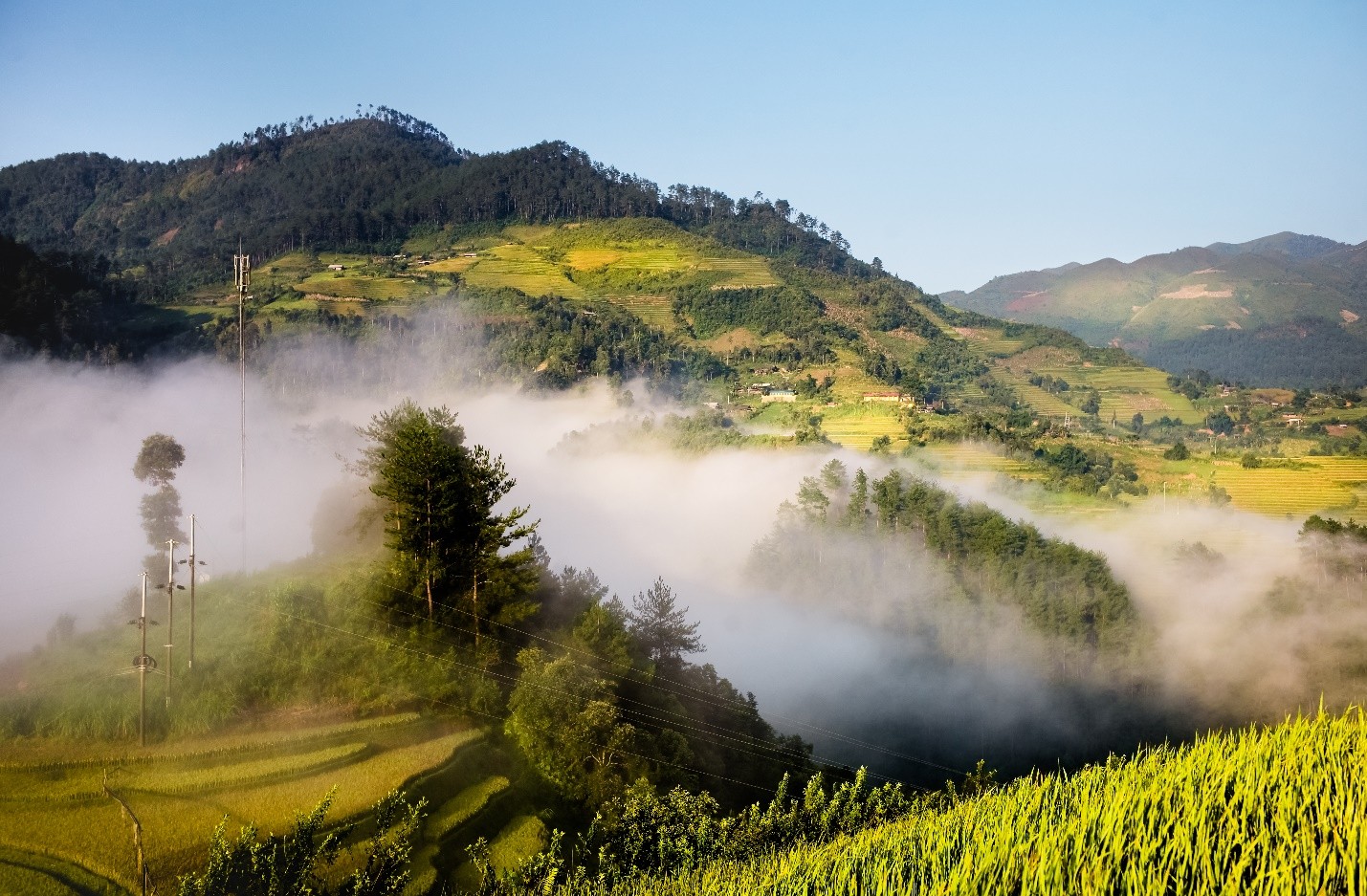
Morning mist - photo by Dang Van Phuc
Mu Cang Chai, in the local language, means villages and land of dry trees, (Moc Khan Tho - Land of dry wood), it is unclear whether it was due to forest fires or what is the reason for this name? Located at an average altitude of 2000 meters, under the Hoang Lien Son mountain range, 91% of the people are Mong with 4 main groups: Black, White, Chinese and Red. 300 km from Hanoi, the current road takes about 8 hours by car, but in the past, it was a far away area, to the point of assimilating the word remote as "Mu Cang Chai." "Where is your son assigned to go?" During the Subsidy period, people asked each other questions. "Oh my god, I took so long to get into that office, now they let me go far away, "Mu Cang Chai."" They answered each other. Meaning, I was assigned somewhere very, very far away, maybe Central Highlands, Yen Bai or Quang Ninh, such as Mu Cang Chai, places they have never been to, but when they come, it is difficult to return often.
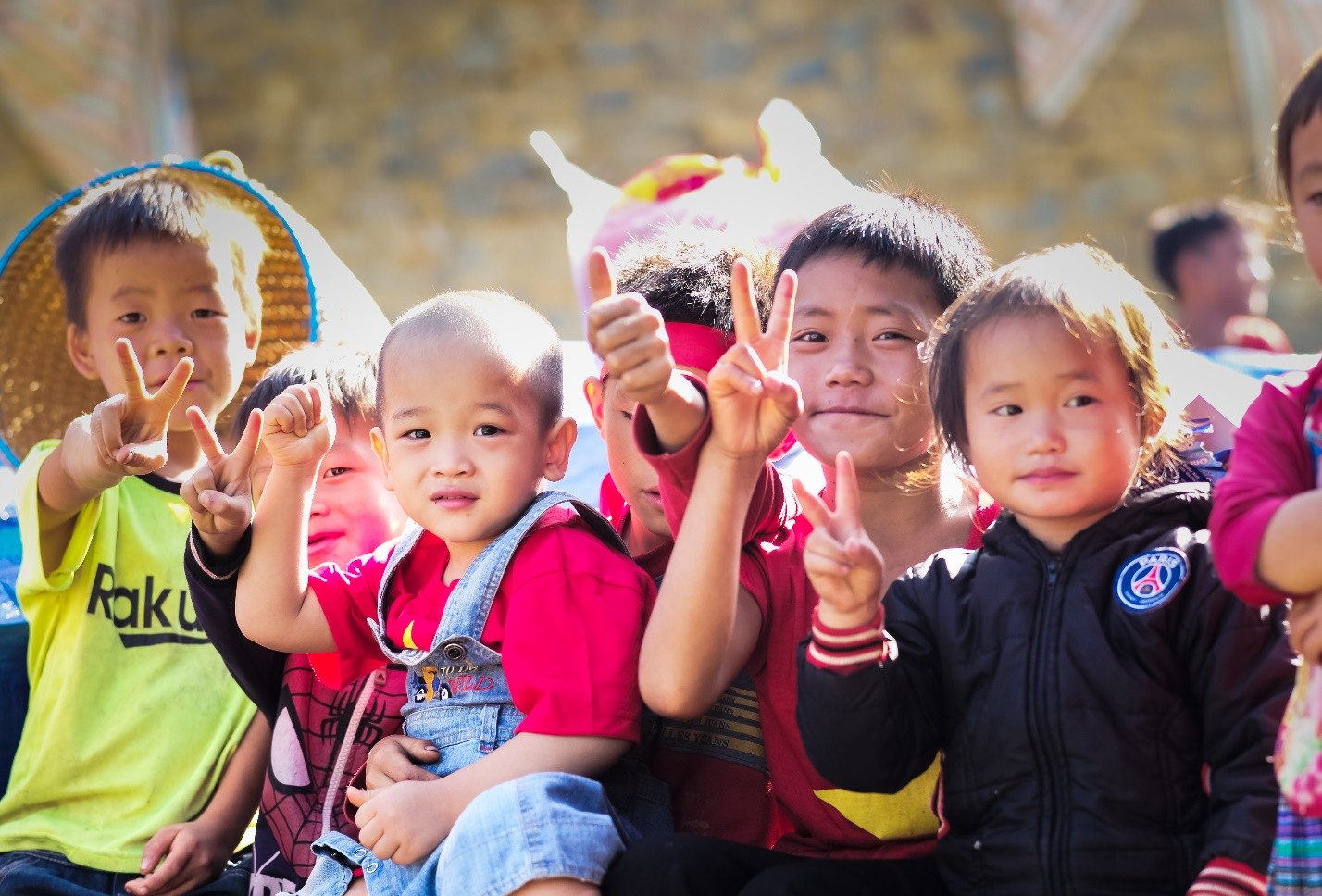
Mid-Autumn Festival with the children in the village - Photo Dang Van Phuc
However, in recent years, Mu Cang Chai is not only a familiar name but also a destination for many people. The backpacking group can go by car or motorbike. They like winding mountain roads covered in clouds. Groups of large displacement motorbikes in groups. Groups of paparazzi often stay up all night or bask in the sun all day. Groups of tourists wearing colorful clothes come to check out the brilliant golden season moments or the high-altitude Hmong villages. Then groups, even individuals of adventurous foreigners, ride bicycles or track on trails. And now, more groups are organizing mountain running races like what happened last week.
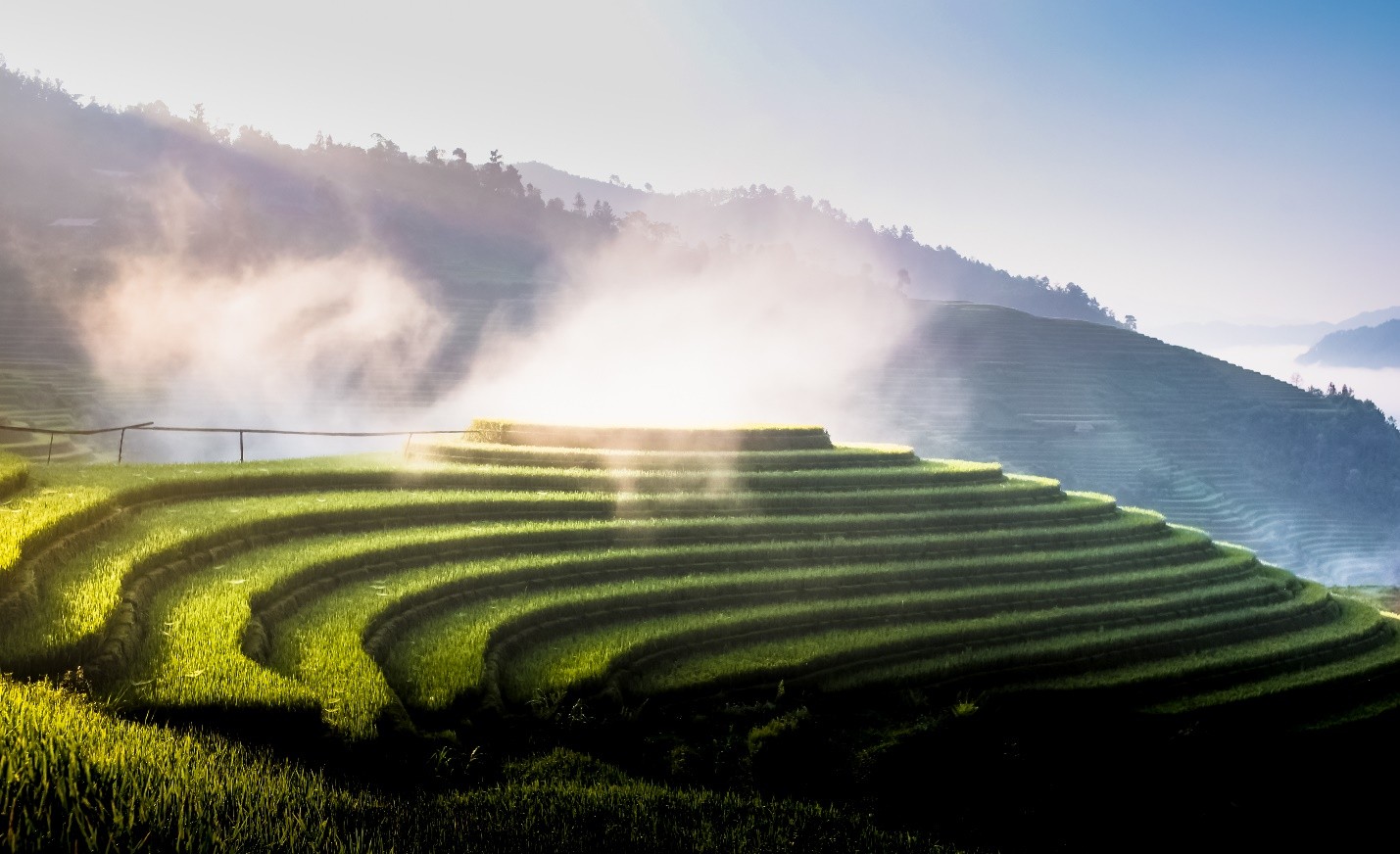
Raspberry field moment - Photo Dang Van Phuc
We, photographers, have been wandering around Mu Cang Chai every golden season for nearly ten years now. Going once is just a feeling that has passed, going twice feels more close, going 3 times feels familiar, going again, then again, the more I go, the more strange I feel, the more I want to explore and the more I want to go again, again. Every time I go up, I only do the same thing, but the difference in weather, the difference in time of day and month, always brings something new, plus the luck of the trip, no one feels bored. Because I have come here many times.
This time, my first surprise among the many innovations of the locality, the town's landscape, and the people, was the motorbike taxi. Truly impressive, motorbike taxis in Mu Cang Chai are probably no different from motorbike taxis in other mountainous areas, but the impressive thing is the quantity. "In La Pan Tan commune alone, last year the cooperative was established with 500 vehicles." H'Lu, a motorbike taxi driver in Nha Ngo village, Mang Mu village, told me. “If you include other communes, there are over 1,000 motorbike taxis!” he added. Can you imagine that 1.6% of the district's population (61 thousand people) are motorbike taxi drivers! In 2023, it is estimated that over 200 thousand tourists will come to Mu Cang Chai.
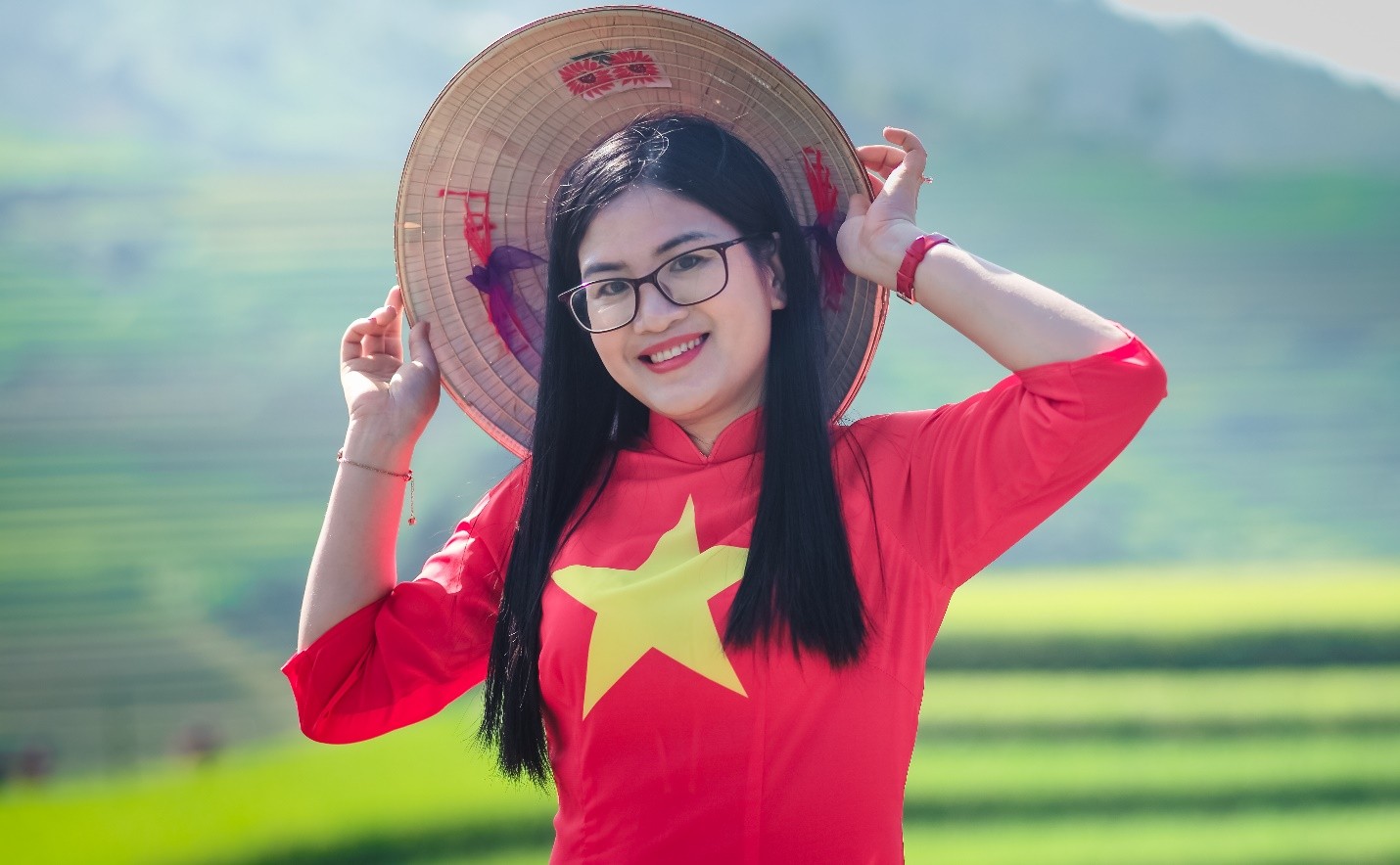
Check in Golden Season - Photo Dang Van Phuc
Why is the number of motorbike taxis so large? Who are they? Mu Cang Chai is located on Highway 32 running through town parallel to the stream below. Nestled under two mountain slopes are beautiful small villages, Thai stilt houses, and now many people's houses have moved up and urbanized the beautiful town. Looming under the clouds on the two mountain slopes are famous terraced fields interspersed with patches of old forests, pine forests or bamboo forests as well as the cloudy roofs of the Mong villages. Besides Mu Cang Chai town, we have 13 communes that are tourist attractions: Cao Pha, Che Cu Nha, Che Tao, De Xu Phinh, Ho Bon, Khao Mang, Kim Noi, La Pan Tan, Lao Chai, Mo De , Nam Co, Nam Khat, Pung Luong. Each point is a Hmong village in the high mountains. From the national highway, if you want to go to the village, there will be a trail, the distance is about 7 - 15 km depending on the village, you have to go by motorbike taxi. And since then, the demand for motorbike taxi tourists has increased.
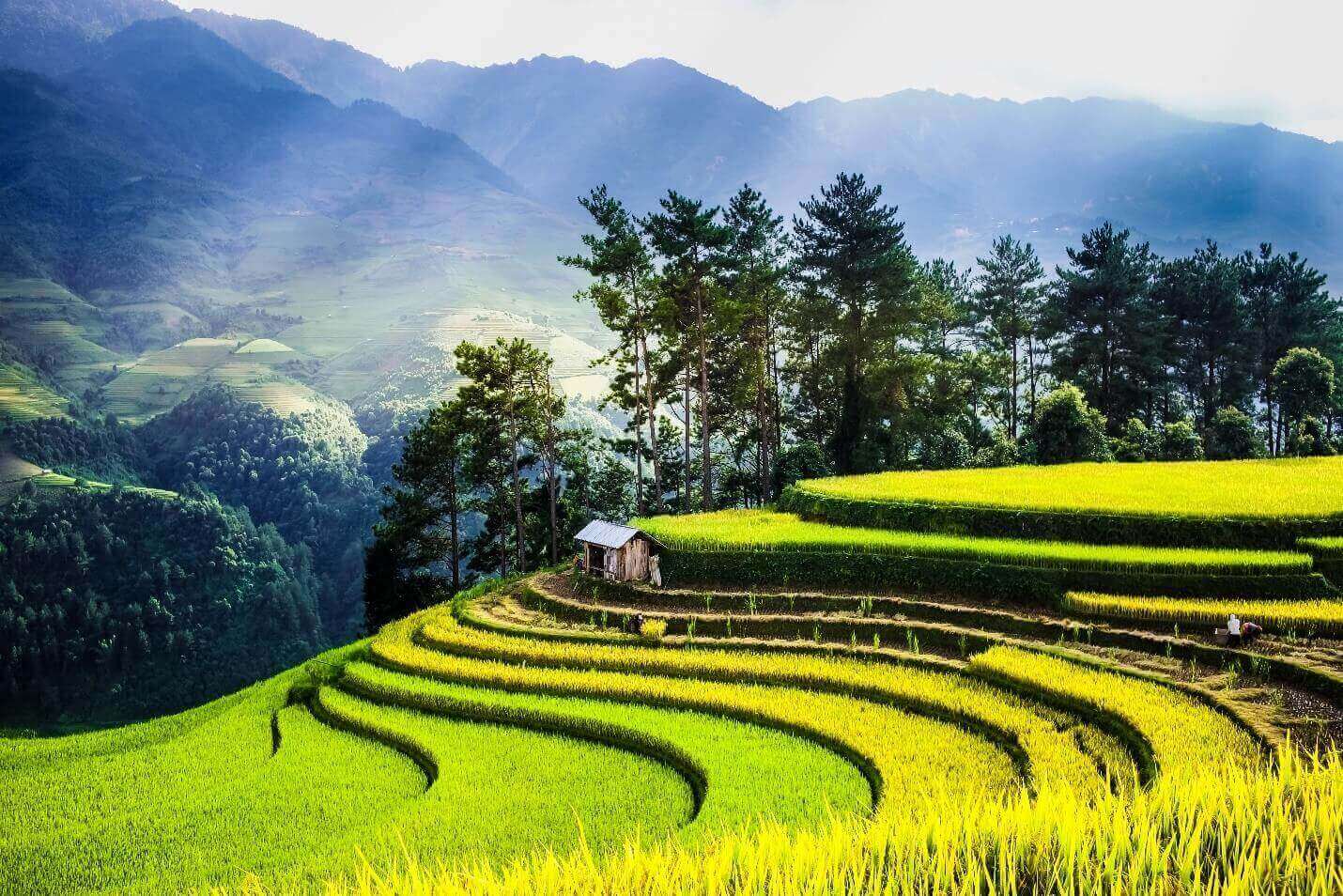
Horseshoe - Photo Dang Van Phuc
It's not like there are motorbike taxis now. There were many years ago. They were also managed by local authorities, but most were spontaneous. Now the commune organizes and establishes cooperatives, with uniformed vehicle fleets. There is management, tickets and general prices, ensuring order for both tourists and services. On average, for each destination, motorbike taxis both go there and back range from 100,000 to 200,000 VND/person. "Motorbike taxis have jobs and are only concentrated for about 2 months of the year. When the season ends, there are very few customers." H'Linh, a motorbike taxi driver, took me to the Raspberry fields to share. "The road has been concreted for the past two years, so it's easier for vehicles to travel and less dangerous." H'Linh answered the corner while I asked. Because the car had just gone up a steep slope and turned left downhill, the engine's sound was quieter so it could respond.
From town, drive on the highway for more than ten kilometers to reach the foot of the mountain to go to the Raspberry field. From the foot of the mountain to the mountain is only about 1.17 km but it is steep. 3 years ago, the dirt road had ruts for motorbikes, which was very dangerous. Now it is a concrete road. From the town, about 1 km away is the up and down point of Horseshoe field (Mo De), Bamboo forest, about 2.5 km up the vertical slope, there is also a concrete road big enough for 1 motorbike. . A little further, 7 km both going and returning is Kim Noi commune, passing Hang Dang De school.
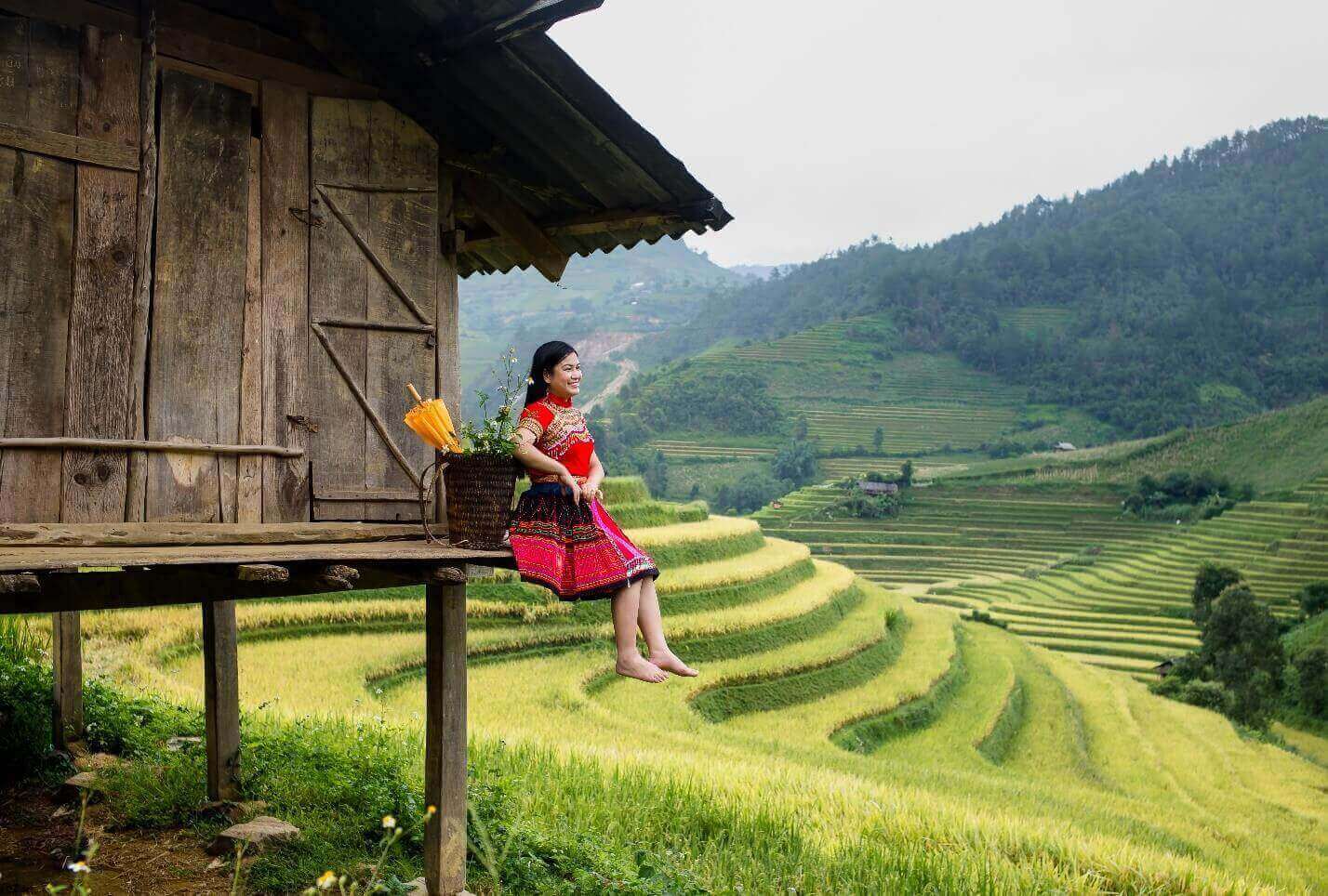
Check in on Golden Season - Photo Dang Van Phuc
Most of the Mong villages are in high mountains, with altitudes from 800 to more than 1,700 meters, on both sides of the mountain sandwiched between Mu Cang Chai town. "After harvest, threshing, threshing and then the rice is carried down? ” I once curiously asked the women threshing rice and the children surrounding the wooden box that was both a grain container and a threshing table. “No, you have to carry the grain back home, back to the mountains.” A woman stopped beating, wiped her sweat with her hand and replied. Following the pointing arm, I looked up at the cloud-covered mountain. Looking at the sacks of rice, it's hard to imagine how to carry them up because we had to hire a motorbike taxi to climb to this point, which was already very high. We thought that carrying the rice down was already difficult, now they say we have to carry it up to go home...
Not only rice, corn, cardamom, hawthorn or loquat, the products of the mountains, forests and fields are harvested in the fields and fields below and brought to the house above, dozens of kilometers away from the house. number and climb several hundred meters steeply. H'Linh, a motorbike taxi driver, continued to take me from the national highway to two points of Bamboo forest and Horseshoe. “These two points go the same way, up one way and down one way.” H'Linh said as she changed the car number. The sound of the number 1 engine roaring to climb the uphill slope. Compared to a few years ago, the dirt road was slippery in grooves just for wheels, now it is concrete, which is a huge improvement, even though the road is only about 50 - 60 centimeters wide, enough for a motorbike to drive. Both sides of the road are gradually eroded by the rain. In many places, one side is a cliff, the other side is close to the bushes of the cliff. However, the Mong motorbike taxi drivers still calmly took passengers past.

Field under Khau Pha pass - Photo by Dang Van Phuc
"Bend", perhaps you've heard this word familiar, try bending your arm, looking from the shoulder down and then from the elbow to the wrist, you see, the road here is exactly the same, from the foot of the mountain climbing Up each mountain, hundreds of years of trails have been created with very sharp turns, with only enough room to drive up for those brave enough, with a slope of over 45 degrees and the car's gear always being in 1st gear, making it famous. The engine roared throughout the mountains and forests. "This is a trail that Mong people have traveled for many generations, carrying goods by horse or person." H'Linh shared that when the car goes down, it makes less noise. “Who paid for this concrete road?” I ask. “Some parts are done by the state, some parts are done by the people themselves.” H'Linh replied.
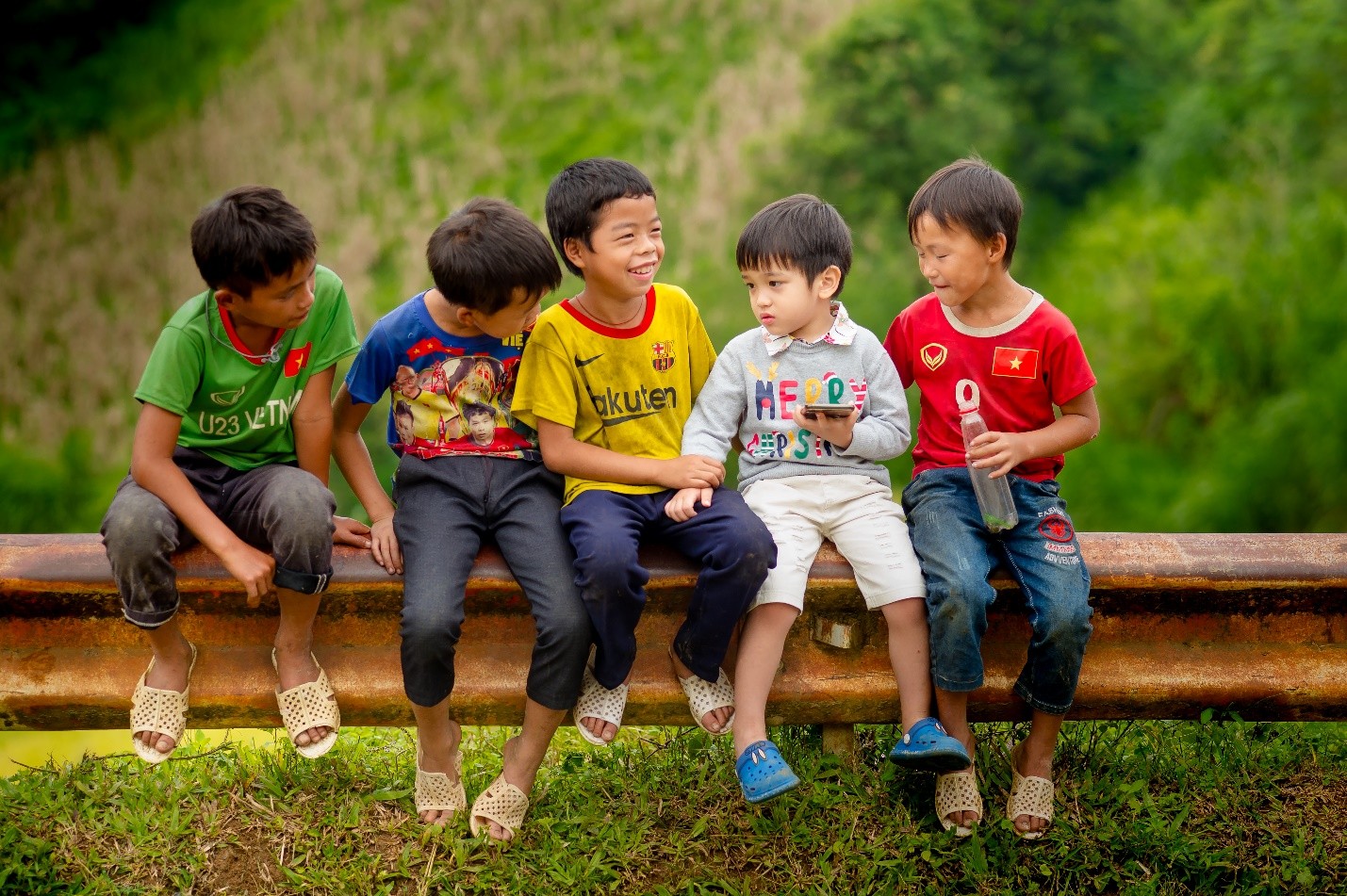
Mong children - Photo Dang Van Phuc
Many single-track roads connect villages and inter-communal roads, roads connect high cloud-covered mountains. The other thing is, even from the bottom of the mountain to the top of the mountain, each road has dozens of bends and folds, but from below or from afar, the road is almost invisible. We hardly see any photos of these roads, and imagine, it would be very grand and impressive if we saw them. This is something to be happy about, because the roads run under the canopy of forest trees, protective forests, natural forests, pine forests or even home gardens of the villages, which are lush green covering the mountains.
The car climbed up and up until it got close to the top of the mountain before reaching the Bamboo forest, a very beautiful green patch, as impressive as in the movie "Thap Dien Ambush" by Truong Yimou. Because it was only Friday, there were no customers, alone. I went into the forest to explore. “You looked at it so quickly?” H'Linh was surprised to see me come back. “If regular customers go down there, we have to wait for an hour.” H'Linh gave me the helmet and added. That's right, if I follow a few more girls along with a camera, I'll probably end up staying at this one place for the rest of the day.
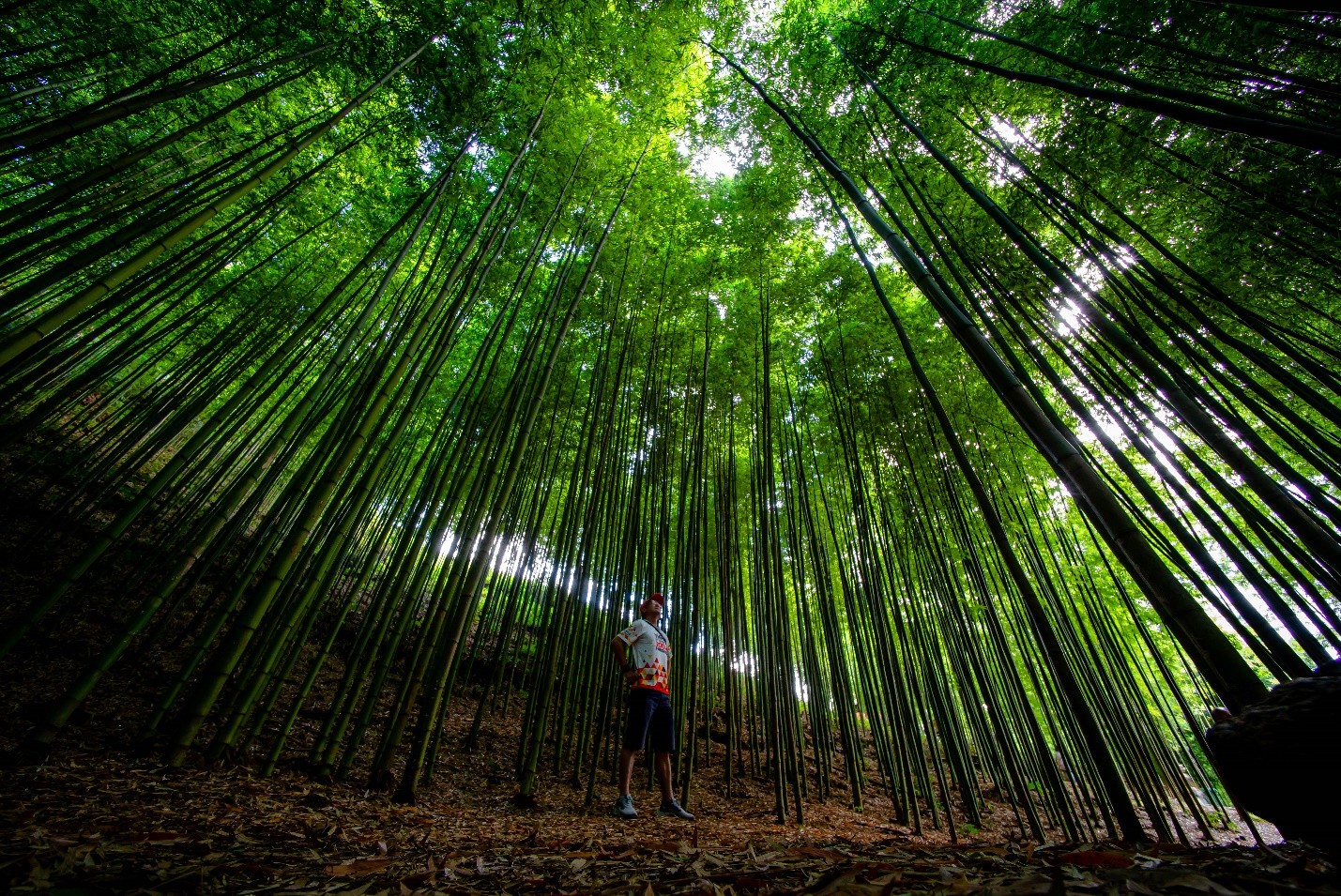
Bamboo forest - Photo by Dang Van Phuc
The car went completely down, still with curves, but on this side of the mountain to go to Horseshoe field. “Last week, the race was here, did they run this route?” I asked H'Linh. “Yes, they go up and down the slopes we just passed.” H'Linh replied. “Do you get tired watching them run?” I asked again, "This is ridiculous, everyone looks drenched in sweat. They just left, how can they run?" H'Linh said and shared more, "We also go this way carrying goods, before it was slippery, but now it's easier, especially since we have a motorbike, so we take it to the district market or take it home faster."
The horseshoe field is very deep below, the carts go down and through many mountain slopes to reach it, which means that when they finish harvesting, they have to carry the product back up a long distance. There are quite a few photographers here standing on their feet. They climb straight from the road so they are faster, climbing just over 2 km high. There are also quite a number of tourists coming to the stilt houses and photo spots. Everyone is waiting for sunset, when the sun slowly disappears from the mountains in the distance. Many people come from the south so they are very excited about the landscape and the rice fields ripening under the afternoon sun. Foreign tourists travel in a different way, so they rarely collide with crowds of Vietnamese tourists. Including trail running events, since the Covid epidemic, foreign runners have participated in large numbers. For example, at VMM Sapa recently, at a distance of 21 km, there were nearly 1,000 people, 70% of whom were foreigners! In Mu Cang Chai, foreigners go deep into the Mong villages, discovering the cultural features and daily life scenes of the people. Most Vietnamese people follow the crowd, checking in to places on newspapers and social networks that produce beautiful photos.
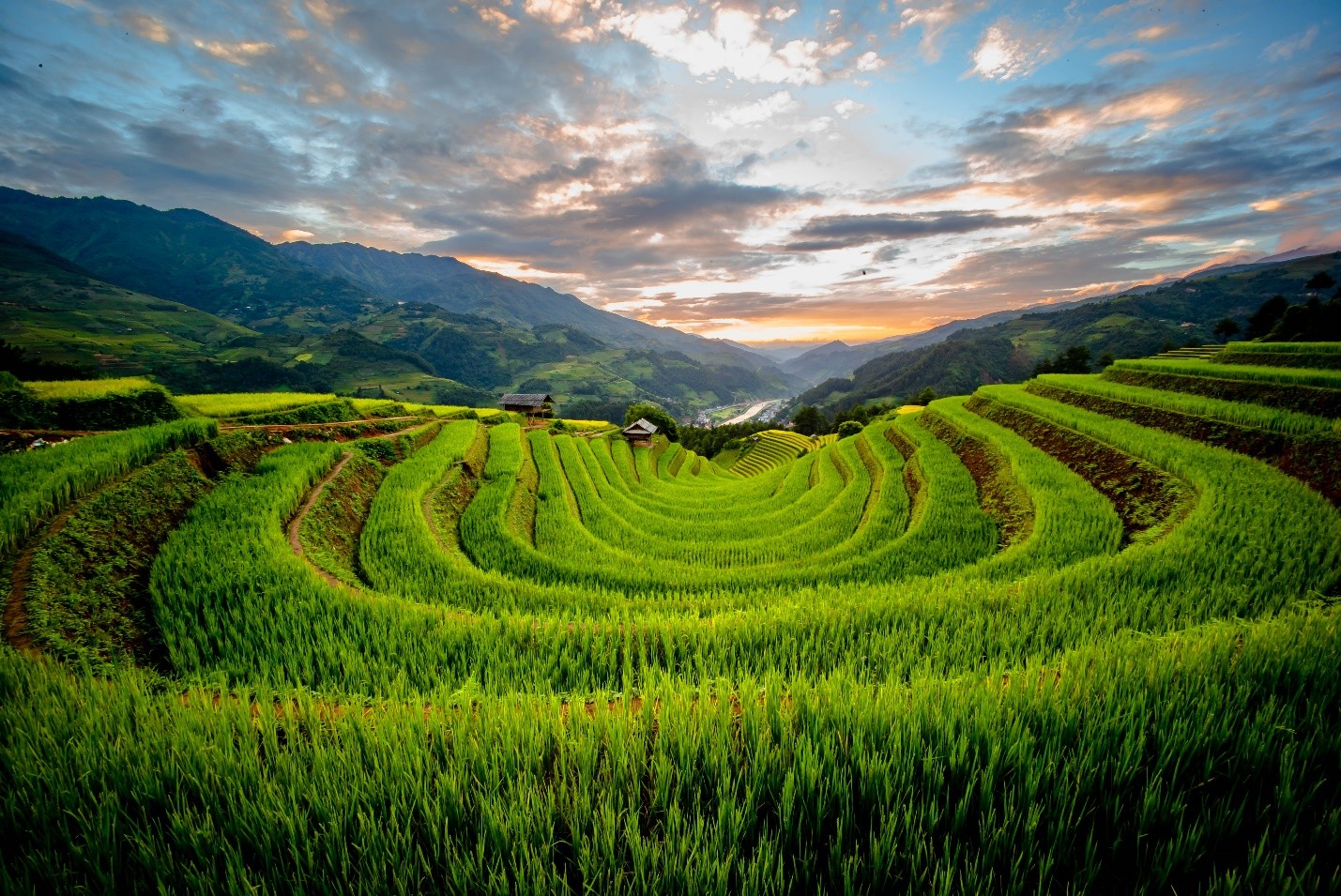
Horseshoe Field - Photo by Dang Van Phuc
I asked H'Lu, a motorbike taxi took us to Kim Noi village, on the mountain opposite Mu Cang Chai, crossed the bridge on the other side of the stream, and climbed back up like going to Ngo's house. “Last week they didn't run this side, but last year they ran.” H'Lu answered me when talking about the race route on Sunday. The vehicle had to wait for a buffalo group to pass by. I asked H'Lu, "What are the buffaloes raised here for?" H'Lu replied, "We only do breeding and meat, now we do it by machine." According to H'Lu, horses are usually used to transport agricultural products, but since he grew up, no one has raised horses for decades. The horse is a friend, a relative, but raising a horse is very hard. "On rainy, sunny, cold days, you still have to go get grass and food for the horse, you still have to take care of it, now the motorbike is much better." H'Lu added.
Cattle raised in Mong villages are cold-resistant breeds, unlike other places. They raised and cloned on the spot, "Project 135 gave each family a buffalo, after one year, it all died." H'Lu told. In the cold season, they have to cover and cover their livestock, but many years later, many still die. Varieties that can withstand the cold must come from the local area. If they are brought from another place, if they cannot withstand the cold, they will all go upstairs to the kitchen.
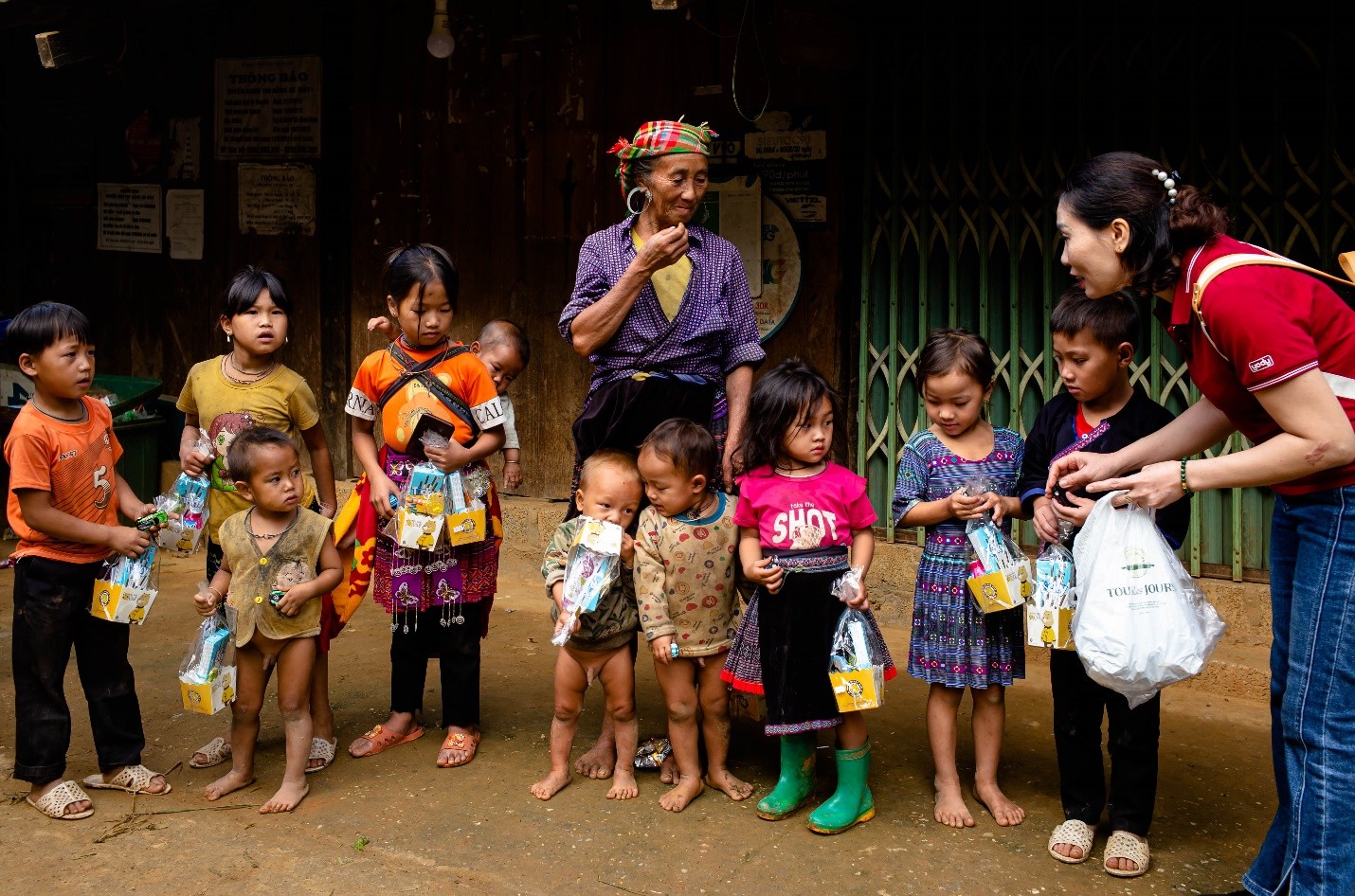
Children on Ngo House - Photo Dang Van Phuc
Nhà H’Lú ở bản có nhà Ngô, phía núi bên kia, Kim Nọi ở phía núi bên này “Cách nhau khoảng 15 cây số, nhưng lên và xuống hai ngọn núi, trước đây sang nhau phải đi bộ hết một đêm đấy.” Anh ta kể về chuyện lứa đôi, phải đi hẹn hò như vậy. “Còn cướp vợ không?” tôi cười và hỏi. “Không, giờ phải ưng nhau rồi lên xe đi thôi, không cướp nữa.” Theo H’Lú, trẻ học lớp chín, khoảng 14 – 15 tuỏi là đã lấy nhau, sinh con đẻ cái. “Chúng nó cứ ở với nhau thôi, chờ đủ tuổi mới làm lễ cưới.” H’Lú giải thích, chưa đủ tuổi nhưng cha mẹ cho chúng ở với nhau và thực tế là một gia đình mới, có vợ, chồng, rồi con cái. Nhưng để có chứng nhận kết hôn, phải đủ tuổi theo pháp luật mới đi đăng ký và có thể làm đám cưới nếu muốn.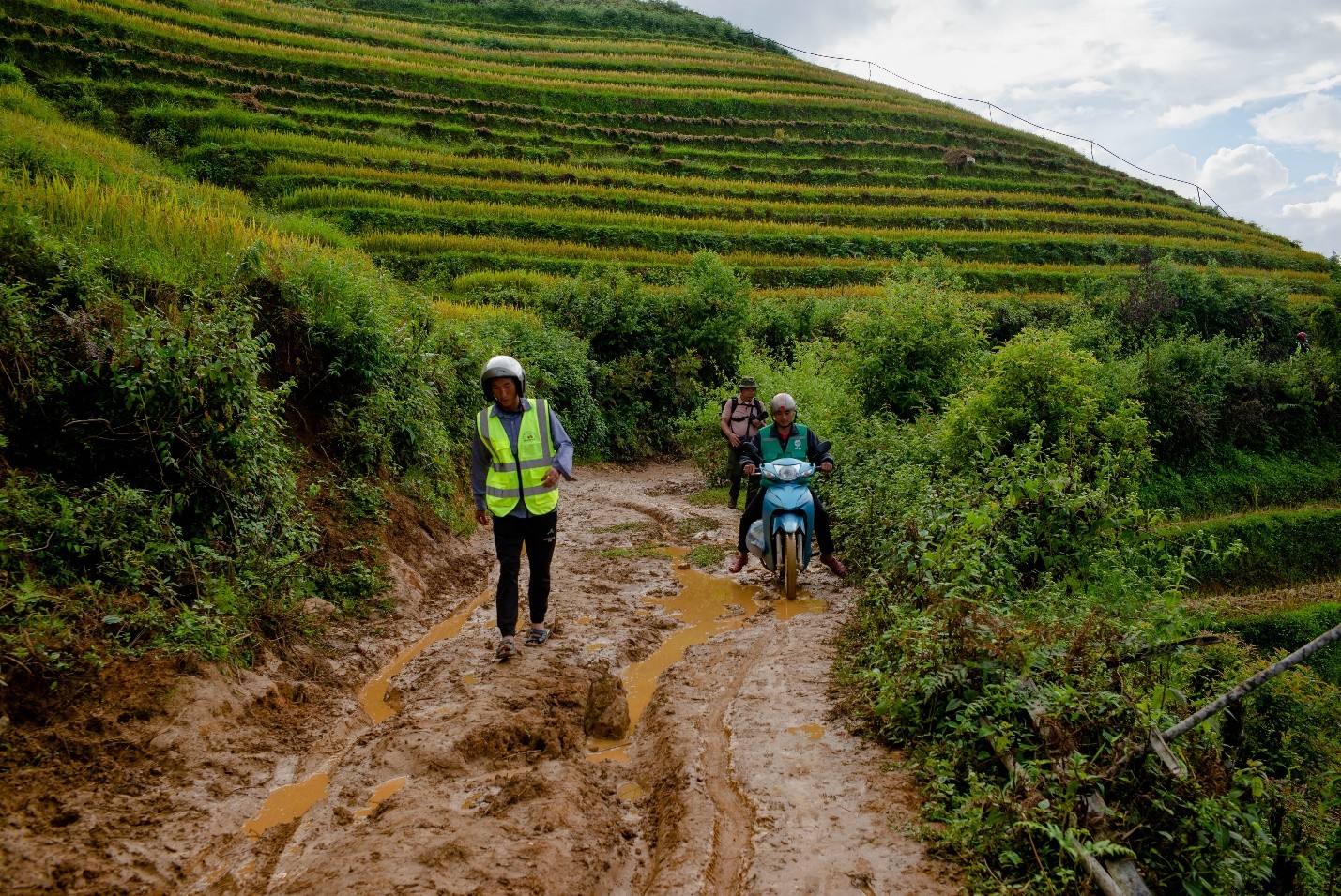
Road to Kim Noi - Photo by Dang Van Phuc
“Do people from the lowlands come here to buy land?” I asked H'Lu, he said, "Yes, if they buy land to trade or live, they buy it in the district, but there are people who buy it for farming to grow medlar, hawthorn, or cardamom, and they also hire Mong people." I do it.” I continued asking, "Do Mong people sell land?" Why do you need to sell? Another long story, H'Lu shared, those terraced fields are inherited by the entire clan and family. Many generations have discovered, "There are very few new fields, even though there is land, it is not easy to bring water." H'Lu emphasized. The number of terraced fields represents the wealth and position of the family. But if there is an addict in the family, it must be sold. If you have a family with many children, you will have to share with them. “Each family now only has cloth and a piece of field.” H'Lu spoke in a lower voice.
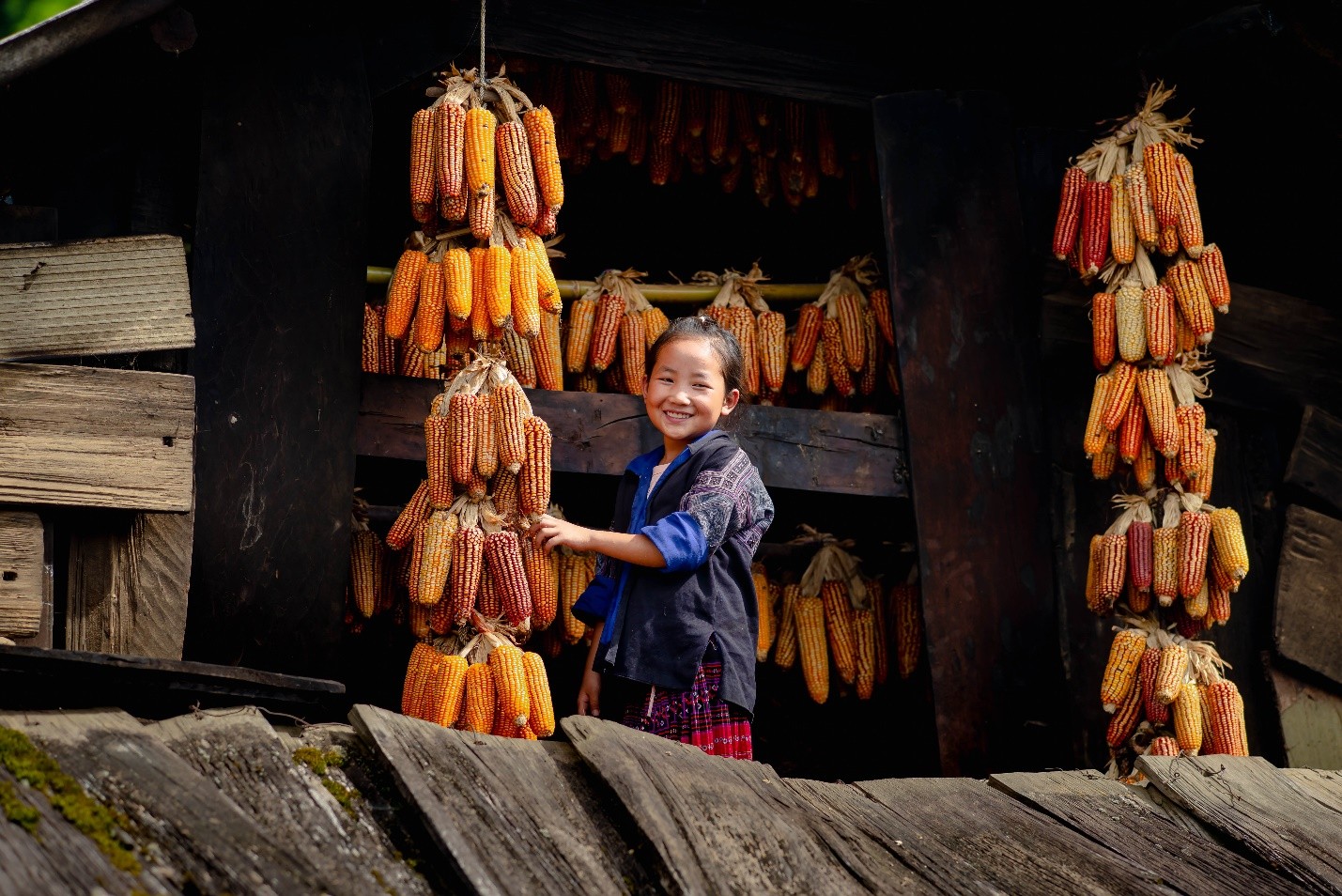
Baby on Ngo House - Photo Dang Van Phuc
Not every family has money to buy a motorbike, and driving a motorbike taxi is only possible for about 2 months of the golden season. During the flood season, the demand is less, most people only take pictures, and tourists rarely come during the flood season. “If there are motorbikes, why do so many people still have to carry goods to the village on the road?” I asked curiously. “Many old people don't know how to ride motorbikes, they still have to bring goods home.” H'Lú said and added, "Old people work more than young people." Older people don't ride motorbikes, so they get up earlier, sometimes at 3 or 4 a.m. to go down the mountain, work, and then return home until late at night after packing. For them, the concrete road is only less slippery, but the slope is still the same, their life is still the same.
At the end of the golden season, the Mong people return to work, returning to the cardamom fields, apple orchards, loquat trees or working for projects and works in the district. Many families' children also escaped to work as workers elsewhere. "There are 3 children in our family, the daughter went to work at an auto factory in Hoa Binh." H'Lu boasted. With a large number of motorbike taxis of thousands of people, each point up the mountain has hundreds of motorbike taxis, so every time a tourist bus comes, they rush to look for passengers, not unlike the My Dinh bus in the past. That's why motorbike taxi cooperatives were established and numbered. Each person can get a few trips per weekend, enough to earn 300 - 500 thousand, which is quite high compared to their other jobs. The cooperative will also collect 20% on the trip.
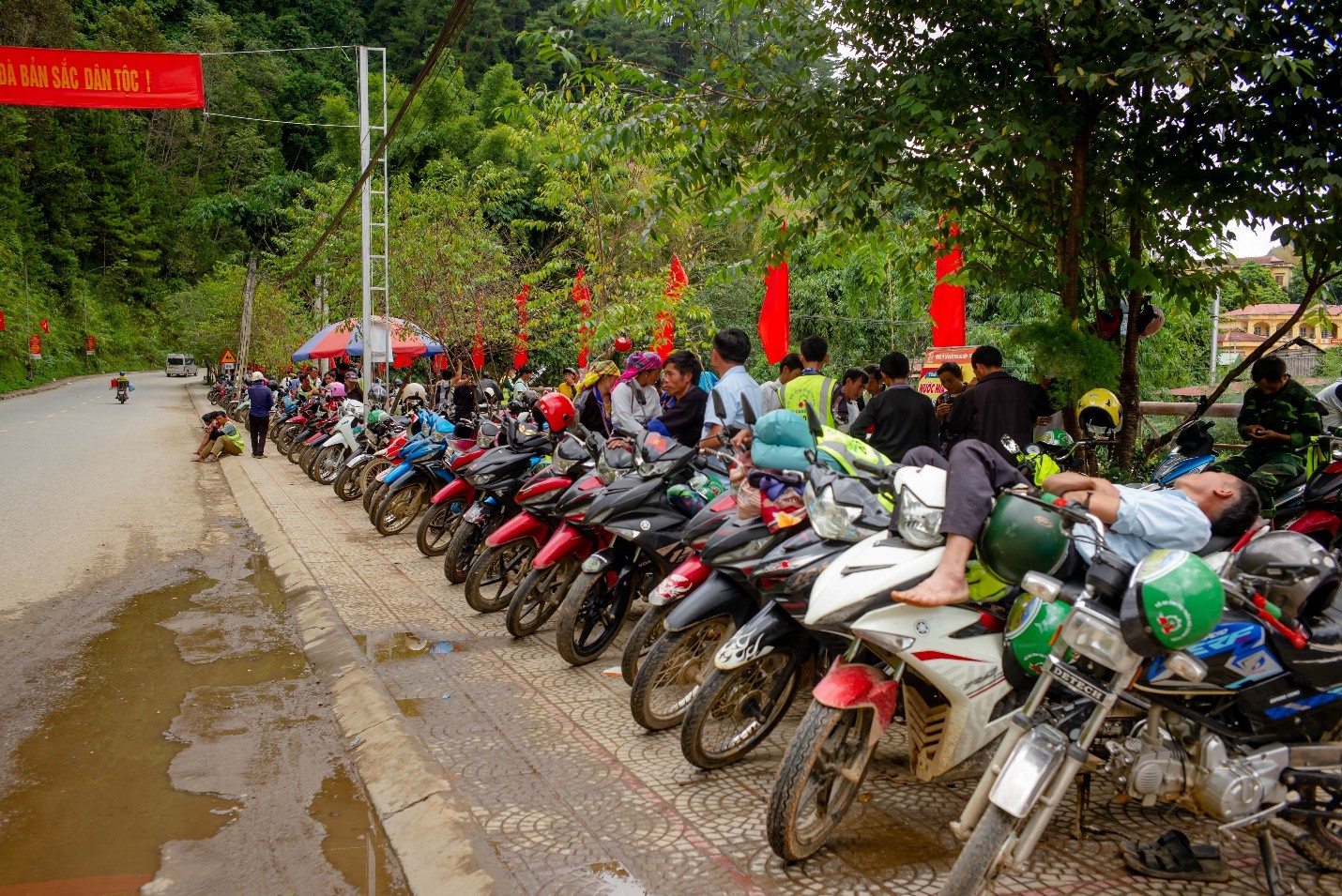
Horseshoe motorbike taxi - Photo Dang Van Phuc
“Is there a team that can repair mountain climbing passenger motorbikes like this?” I asked H'Lu, "No, everyone fixes their car at their own expense." H'Lu replied as he returned me to the dock. With heavy mountain climbing activities, the vehicle breaks down very quickly, and is dangerous if climbing steep hills. Repairing it and being ready to operate well for each trip is also a concern not only for the driver but also for ensuring safety for the driver. Tourists are also the responsibility of local authorities.
Terraced fields when the sticky rice is ripe and shiny golden spread across the hillsides. Visitors to Mu Cang Chai witness with their own eyes green and yellow raspberries appearing among the vast hills and mountains. Stopping at the three communes of La Pan Tan, Che Cu Nha and De Su Phinh, everywhere visitors can see terraced fields spread across the hills.
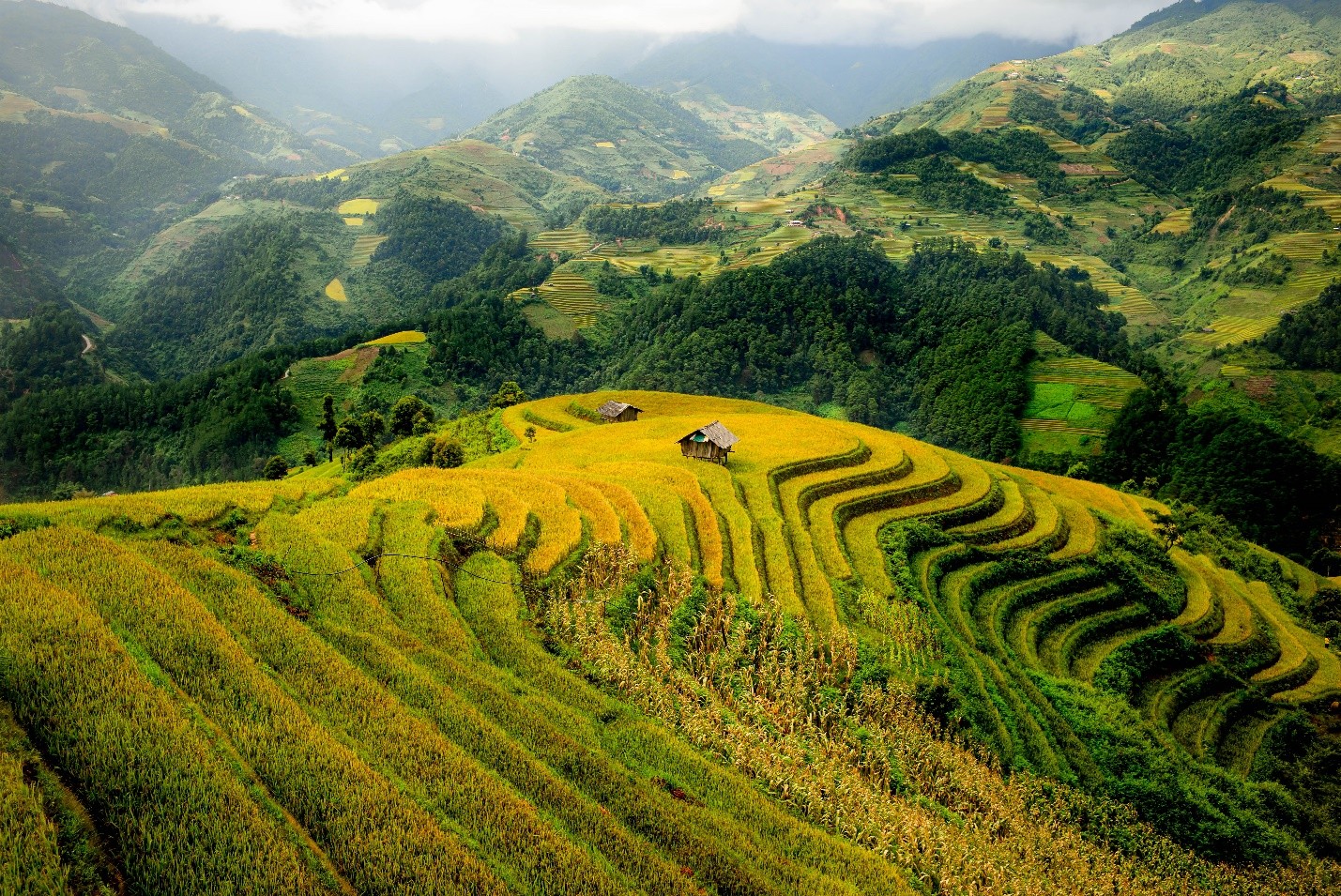
Fields on Kim Noi - Photo Dang Van Phuc
Mu Cang Chai is still known as "the land of clouds, high mountains and deep ravines". The stream and stream system of Mu Cang Chai is quite dense, running along Highway 32, Nam Kim is the largest and only stream in the district flowing in the Southeast - Northwest direction. Nam Kim water flows murmuring all year round, dividing Mu Cang Chai into left and right banks, bringing rare poetic beauty to the Mu Cang Chai highland. In addition, Mu Cang Chai has many small stream systems such as: Nam Hu, Nam Mu, Nam Muoi, Nam Co, Nam Pang, Nam Khat, Nam Khot... contributing to bringing a cool, fresh climate. Along with the system of streams and streams are a series of famous, multi-layered waterfalls such as Nam Mo Waterfall (Mo De), De Thang Waterfall (Che Cu Nha). Visitors will be immersed in white water streams.
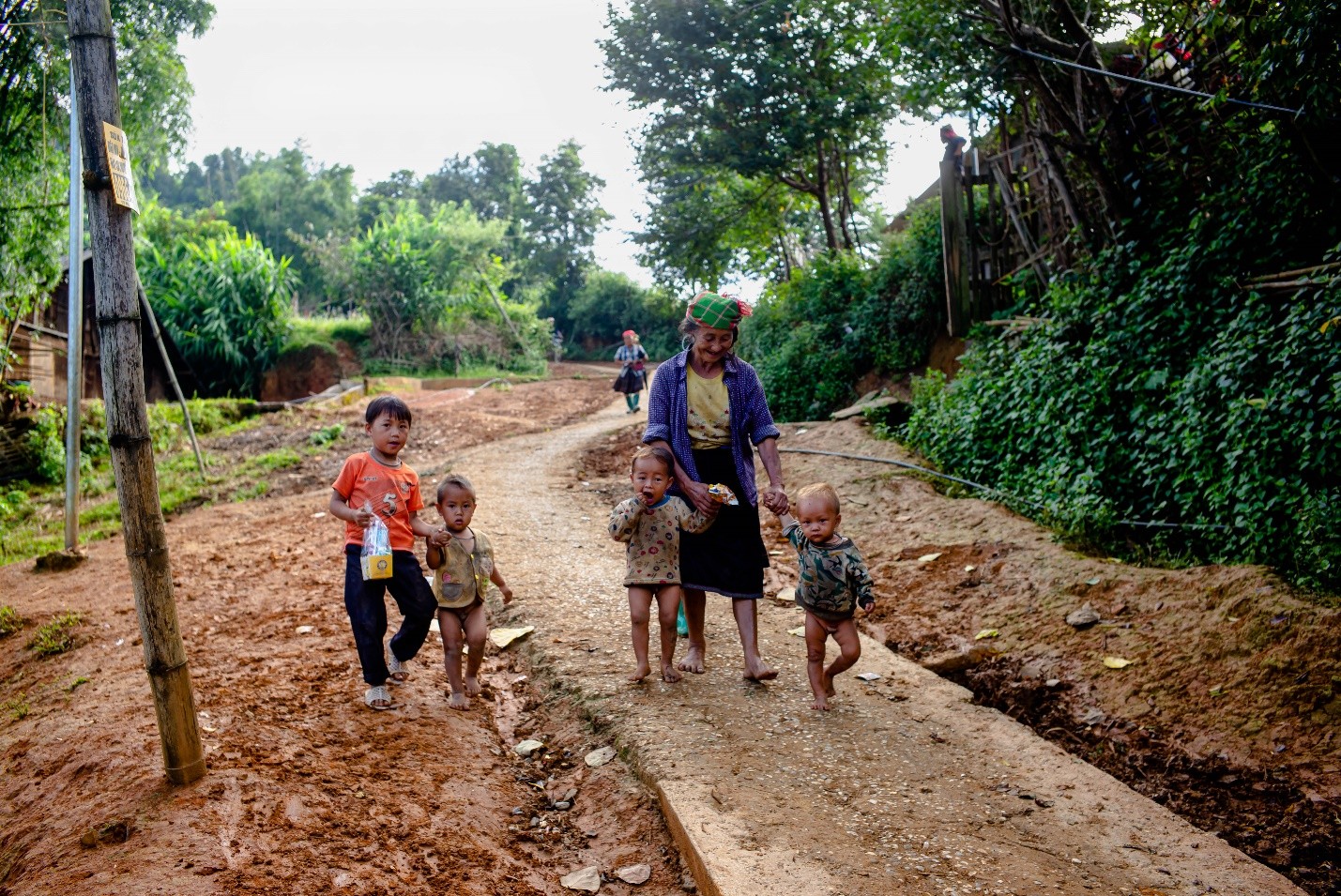
The road is concreted - Photo Dang Van Phuc
Along both sides of Nam Kim stream, the banks are built with embankments as well as a rather poetic road between two bridges. After 8 o'clock in the evening, I enjoyed jogging along the stream, about 1 km each way. On the shore there are rafters like seats for visitors to watch. Each pair of boys and girls were teenagers still wearing school uniforms, each couple had a section, probably all Mong people, I guess.
Pu Nhu Waterfall is located 10 km west of Pu Nhu village, La Pan Tan commune. Originating from streams in the forests upstream from Than Uyen district - Lai Chau, the waterfall has a high slope with a water column of about 20 m divided into many steps. Thac Mo, Mu Cang Chai district, is located between two hills of Na Hang A and Na Hang B, in Mo De commune. During the journey to conquer Thac Mo, there are 7 impressive points for visitors to stop and enjoy. From the district center, it takes about 30 minutes to walk to Thac Mo. From here, visitors will reach the point of a one-story waterfall where the water flows in a spiral shape. To reach the 4-storey waterfall, visitors must continue to walk upstream. This is also the most impressive place for visitors to save beautiful images of Thac Mo. In addition, visitors can also visit the caves of Nam Khat commune, conquer the mountain peaks of Pung Luong commune and Lao Chai ancient rock field.
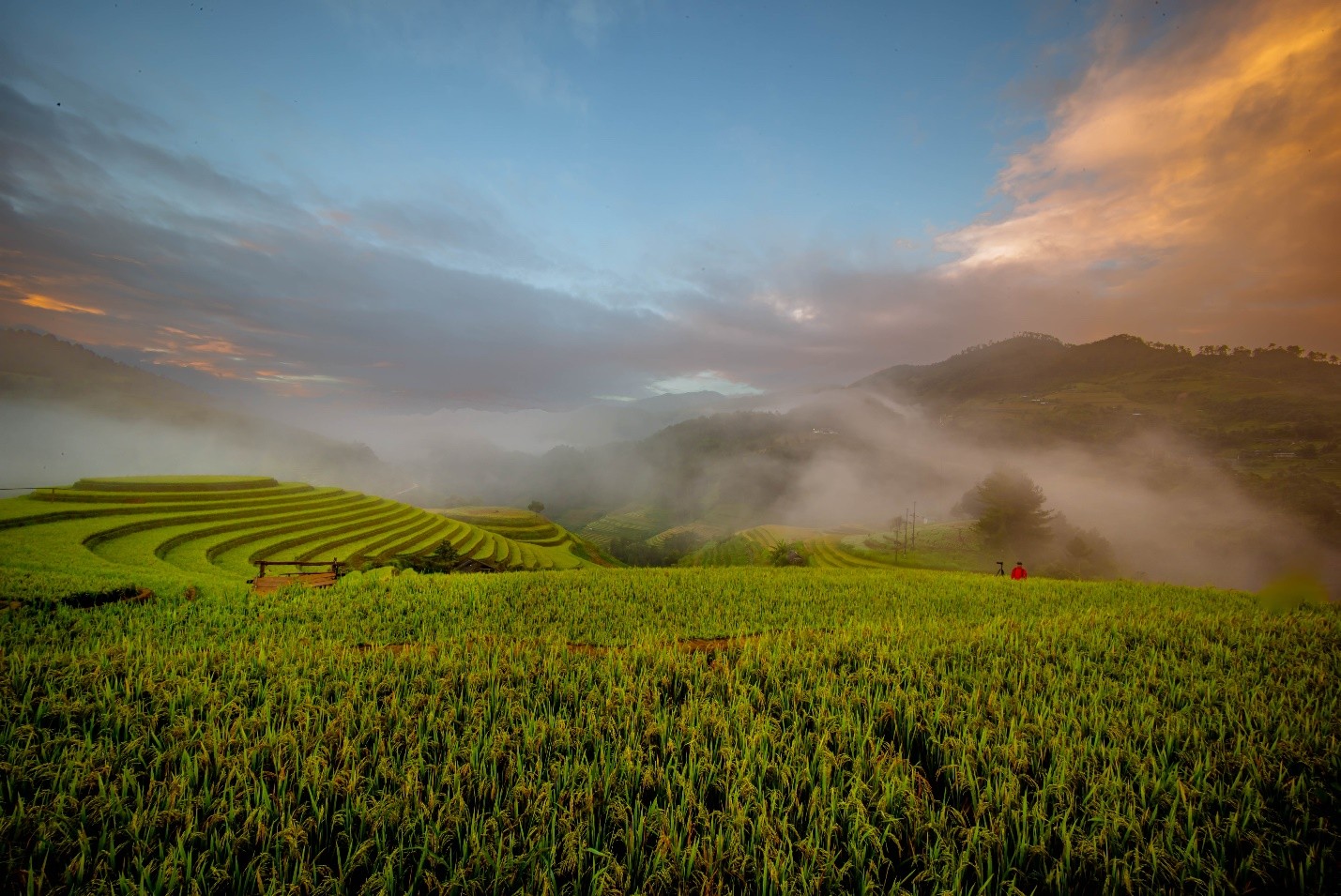
Early morning in the Raspberry field - Photo Dang Van Phuc
Leaving town, on the way back we stopped at Khau Pha Pass, the "Horn of Heaven" pass is one of the "Four Great Passes" including the 4 highest passes in Vietnam: Ma Pi Leng Pass, O Qui Ho Pass , Khau Pha Pass and Pha Din Pass. On Friday night, there was a landslide in the mountains, so many vehicles from groups taking photos and tourists had to turn back to Tu Le to rest and wait until noon on Saturday for the landslide to open to traffic to continue. There is a very beautiful paragliding spot here, flying over the golden season in the valley. This is also the place we often visit to take photos of the ripe rice fields below, but this time, the entire rice field has been harvested. Maybe this year the rice here ripens earlier than usual?

Family pounding green rice - Photo Dang Van Phuc
Back to Tu Le, a famous place for sticky rice nuggets, white Thai families manually pound green rice flakes for tourists. For every visitor who visits, before leaving Mu Cang Chai, everyone wants a gift. , at least the sweet green grains from the rice fields in the cloud-covered mountains, filled with the sun, wind, and rain of heaven and earth. When mentioning a place with charming beauty from beautiful terraced fields, a space filled with the scent of sticky rice, and the clarity of morning dew, we are talking about Tu Le. This town is a valley of nearly 3,000 hectares located under three mountain ranges Khau Pha, Khau Song and Khau Than.

Com Tu Le - Photo by Dang Van Phuc
Leaving Mu Cang Chai, we promised to return next year, during the flood season to have new, different moments compared to the golden season. The more times I discover things, the more strange it becomes.
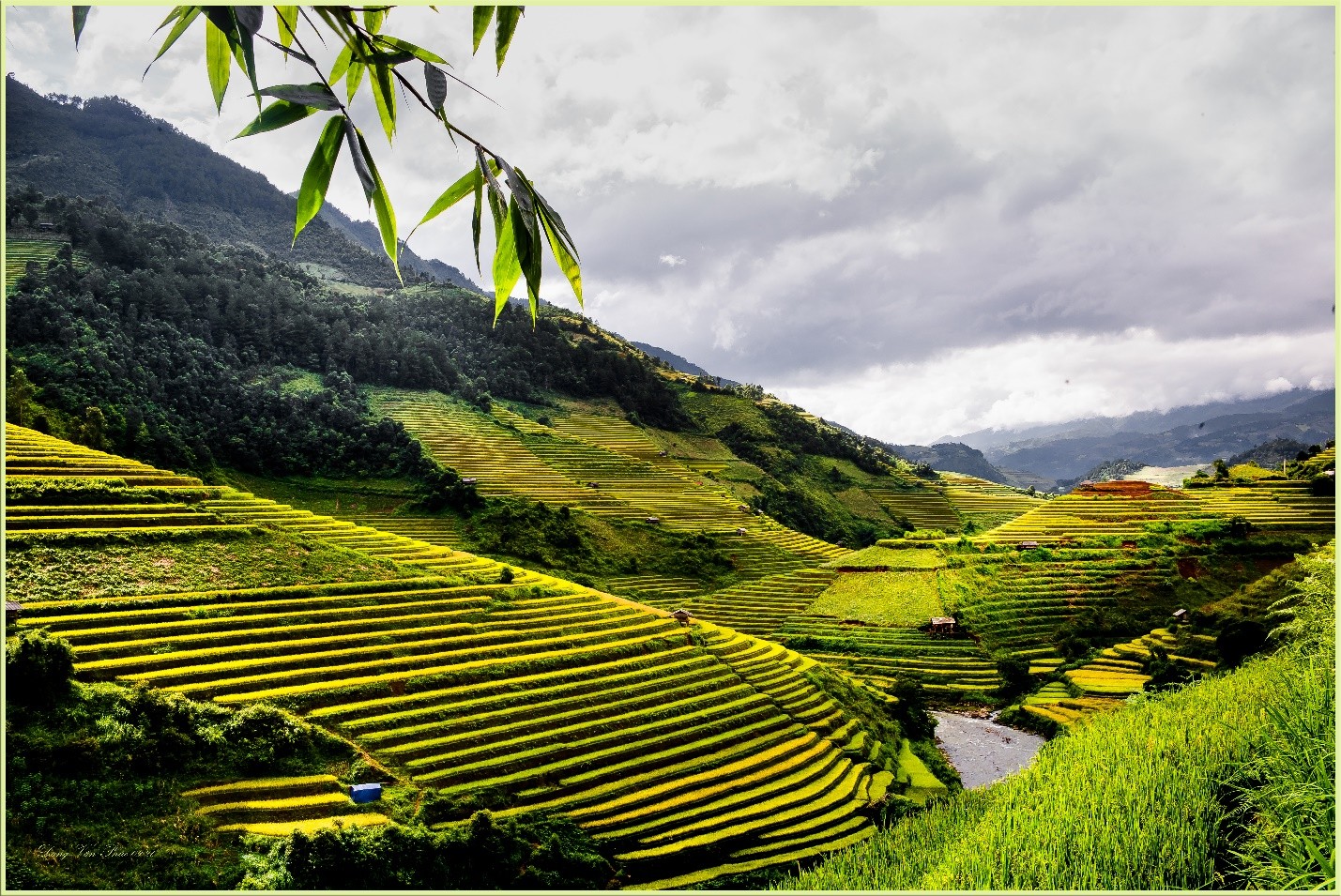
Terraced fields on every hill - Photo Dang Van Phuc

The author and H'Lu on the way to Kim Noi
Lao Cai 3664 view
Update day : 03/10/2023
Ham Rong Mountain - with the image of natural cliffs stacked on top of each other forming the shape of a dragon's head, has become an eco-tourism area that attracts the most young people in Sapa. Past the ticket gate, you will see the stone stairs leading up to Ham Rong Mountain. Remember to arrange a reasonable time to fully visit this majestic mountain. It will take you about 2 hours to fully visit Ham Rong Mountain Ham Rong Mountain eco-tourism area was built to include 3 main areas: Ham Rong Flower Garden, Thach Lam Stone Garden, Ham Rong Peak. You will have the opportunity to see the panoramic view of Sapa town from above. This place is also especially popular with photographers because you can capture the frame of Sapa town hidden among the white clouds like a fairyland. To reach Ham Rong Mountain, it will take you a few minutes to walk to the ancient Stone Church, located near the center of Sapa town. If you rent a motorbike to actively move around, you can park it at the resort gate. The parking lot is run by the barbecue sellers themselves, but rest assured it won't be cut off. Parking prices will depend on the time of your visit. In case you do not know the way, rent a hotel far from Sapa town center, you can choose a motorbike taxi or taxi to get around. The locals are very familiar with the roads and because it is such a famous tourist destination, there is no one who does not know Ham Rong Mountain. The distance is quite short, so you can rest assured that you will leave the trip to the drivers. The central flower garden at Ham Rong Mountain is an area that owns flower trees skillfully arranged by talented artisans into the extremely beautiful and sophisticated word Sapa, with a very European and very strange Western style. You can climb up the higher stone steps to get a panoramic view of the beautiful flower garden. The flowers here are all imported from France, Russia... along with hundreds of Japanese cherry trees tested planted in Vietnam. There will soon be another European flower seed production area. You can freely buy flower varieties to plant at home to admire every day. Thach Lam Stone Garden seems to make you lost in a fairyland with stones that remind you of dragon claws and dragon scales, looking very unique and interesting. This area has many giant cliffs, which are natural creations, so you will be amazed by the wild beauty that nature bestows. Thach Lam Stone Garden is the most chosen place to check-in at Ham Rong Mountain because of its small, winding, romantic roads, the maze of rocks that you can't find the way out... Can you feel the enchantment of tree nature? Is there a mortar here yet? The Japanese peach garden at Ham Rong Mountain will bloom extremely beautifully on New Year's Day. There are also varieties of faded peach trees, deep peach trees belonging to the group of ancient peach trees with extremely wide flower canopy, big beautiful flowers, thick petals like peach blossoms. Every spring, the peach garden at Ham Rong Mountain is crowded with families and relatives coming to visit and enjoy the flowers, so the atmosphere is always bustling and full of laughter. The entire orchid garden has a total of 200 different orchid varieties. Because the climate is cold all year round at 15 - 18 degrees Celsius, this flower grows very well. Orchids are rare and expensive flowers because of the elegant and elegant beauty they bring, but taking care of them is quite difficult. You don't have to waste time looking for any orchid gardens in Sapa because Ham Rong Mountain is one of the places with the largest concentration of orchids. If you fall in love with this type of flower, you must definitely go to Ham Rong Mountain orchid garden once. in that life. Cloud yard, also known as Thien Dinh yard, is the "coordinate" for the best view at Ham Rong Mountain. Have you ever known the feeling of clouds curling under your feet, floating on the clouds? Looking down from San May, you will see all of Sapa town, Muong Hoa valley, Cat Cat village and even beautiful, poetic terraced fields. Follow the cliff and walk another 10 minutes to the brilliant Heaven Gate when the golden sunlight shines through the clouds. This valuable moment will become your unforgettable memory at Ham Rong Mountain. Many famous photographers from professional to amateur have traveled far and wide to come here to hunt clouds through their wonderful lenses. It will be more perfect, if you can wait until sunset, the sunset is more brilliant and perfect than ever. When coming to Ham Rong Mountain, you need to note the following points. Choosing the most beautiful time of the year to visit the peach blossom garden at Ham Rong Mountain is very right when you plan a spring trip with family, friends or colleagues. Ham Rong Mountain also owns many types of cold flowers of temperate climate such as hydrangea, dahlias... and countless other unique flowers. You should visit Ham Rong Mountain in March and April - the months when flowers bloom most beautifully in Sapa. At this time there is less fog so you can see more beautiful scenery. You can also take the opportunity from April to June to visit Ham Rong Mountain when you want to catch the scene of terraced fields in the rainy season, looking like magical silver mirrors. According to the experience of many backpackers from the travel association, you should avoid the months of July and August because at this time the road is very slippery due to heavy rain.
Lao Cai 4025 view
October to May
Located in the floating clouds, Sapa town looks like a foggy city, creating a charming landscape painting. Coming to Sapa, visitors can relax with the fresh, cool atmosphere, with many diverse nuances. Traveling to Sapa, visitors can travel by many different types of vehicles such as motorbikes, cars, or by horse-drawn carriage from Lao Cai city or Binh Lu (Lai Chau). Sa Pa has Ham Rong Mountain right next to the town, any tourist can go up there to see the panoramic view of the town, Muong Hoa valley, Sa Pa, Ta Phin hidden in the smog. Currently, with human hands embellishing, Ham Rong is truly a fruitful landscape of Sa Pa. Coming to Ham Rong, visitors feel like they are lost in a fairy garden, with clouds covering their bodies and bright, colorful flowers on the ground. In Sapa town there is also an ancient church made of stone, and from here going back to the northeast, on the way to Ta Phin cave, there is a monastery built almost entirely of stone on a clear hillside. , cool. Going up about 3 kilometers we will see a cave. In the cave, many stalactites create interesting shapes such as dancing fairies, sitting fairies, distant fields, and sparkling forests. More specifically, when coming to Muong Hoa valley, there are 196 islands carved with many strange images of ancient inhabitants thousands of years ago, but many archaeologists have not yet been able to decode that information. The ancient carving site has been classified as a national monument and is being proposed by our State to be ranked as a world heritage site. Here there is also Silver Waterfall from a height of over 200m, the rushing water creates the sound of mountains and forests. Sa Pa is also the "kingdom" of flowers and fruits, such as peach blossoms, large yellow peaches, small yellow peaches, queen plums, purple plums, tam hoa plums, gladiolus flowers, plum blossoms, pear blossoms, peach blossoms, chrysanthemums, roses... especially immortal flowers that live forever. Coming to Sapa in the snowy season, visitors will also admire surprisingly beautiful natural scenery that few places have. The green color of rice fields on terraced fields is replaced by the white color of snow, creating an extremely majestic scene. There are beautiful and enchanting poetic scenes, there are herds of bell-necked guinea cows leisurely grazing, there are beautiful pine forests shimmering magically under the sunlight... Coming to Sapa, we can shake off all the worries of life. Life is a place where time stops so we can leisurely and freely enjoy heaven and earth.
Lao Cai 3818 view
From January to December
Fansipan peak, also known as Phan Si Pang, Fansipan is located in Hoang Lien Son mountain range, the peak is far from TT. Sa Pa is about 9km southwest. Fansipan peak is adjacent to two provinces, Lao Cai and Lai Chau, in the Northwest region of Vietnam. This place has rolling mountain terrain, steep cliffs, and rough rocky roads. Fansipan's weather at night turns cold. The higher you go, the deeper the temperature drops. For every 100m you go up, the temperature drops 0.6 degrees Celsius. You can go to Fansipan at any time of the year, because every season Fansipan is beautiful in its own way. Spring (February - April of the solar calendar). In the spring, visitors to Fansipan often visit temples on the mountain to pray for good luck and peace. In addition, this season plum and peach blossoms bloom throughout the Northwest mountains and forests, and the weather is chilly, making many tourists excited. Summer (May - July of the solar calendar). Unlike the heat across the country, Fansipan's weather this season is cool (from 6 - 18 degrees). Fansipan with clusters of bright red Azalea flowers, ancient roses, climbing roses, blueberries,... competing to show off their beauty. Autumn (August - October of the solar calendar). Autumn is the season of ripe rice in the Northwest. Coming to Fansipan this season, you will admire the golden terraced fields as beautiful as in a painting. Winter (November – January). When winter comes to Fansipan, you will see snow falling as romantic as Europe in Vietnam. This is probably one of the things that makes Fansipan always receive special love from tourists in the winter. In particular, Fansipan Legend also organizes festivals and cultural events throughout the four seasons of the year. Spectacular scale, elaborate preparations such as: Rhododendron Flower Festival, Horse Hoofs in the Clouds Event, Ripe Rice Festival, Winter Festival, Flower Festival,... Currently, there are 3 main routes to climb Mount Fansipan. Each route will be suitable for different people. You can choose depending on the purpose, health and climbing experience of the group to choose the most suitable route. You can go on a Fansipan mountain climbing tour or go in a group, you need to pay attention to avoid getting lost in the group as well as carefully prepare your climbing gear before going. Below are 3 routes to reach the top of Fansipan including: Climbing Fansipan along Tram Ton road (this is the easiest choice), Sin Chai - Tram Ton route (normal difficulty), Climbing Fansipan from Cat village Sand (highest difficulty). Climbing Fansipan peak, you will enjoy all the wonderful things that the nature of the mountains and forests here have to offer such as: watching the clouds and wind blending with the trees and flowers in the forest, passing through giant rocks, Deep holes, steep cliffs, or bright red Rhododendron flower forests on the mountains, clouds and fog covering the path,...
Lao Cai 4423 view
From January to December
Ta Phin village is not only famous for its pristine natural scenery, terraced fields, etc., but it is also a tourist destination for many tourists who want to come here to learn about customs and bold cultural beauty. national identity. Ta Phin village is located about 17km from the center of Sapa town in the opposite direction to Highway 4D. When going from Lao Cai city about 4-5km, there is a fork that turns onto a small asphalt road. Go a little further and you will see a small asphalt road. Toll booth, each person has a ticket for 20,000 VND, then turn left and go back to Ta Phin. To get here, you can rent a motorbike for about 120-170 thousand VND/motorbike or if you are afraid of steep mountains, you can rent a motorbike taxi or car in Sapa center. In many parts, the car runs along the hillside, on both sides are green terraced fields, the edges of the fields curl close to the back of the hill, creating soft, graceful curves like undulating waves in the valley. . This is a village of the Red Dao people that brings differences in house architecture, home decoration, writing, costumes, jewelry and especially customs and festivals. The goods Dao women sell are backpacks, travel jackets, scarves, handbags, etc. In particular, brocade is an indispensable gift for tourists every time they set foot in Sapa. The patterned lines shown on the brocade are the quintessence of a culture imbued with national identity, making Sapa brocade more different from brocades of other regions. Not only is it a place with majestic natural beauty, Ta Phin village is also famous for its medicated bath service to firm and healthy skin. The medicated bath price is about 80-100 VND/time or you can buy cloth sheets. Precious brocade as gifts for family and friends. Besides, in Ta Phin there are also many photography locations such as Ta Phin Sapa monastery and Ta Phin cave - where there is a limestone mountain range and a branch of the Hoang Lien Son range. With a height of about 5m and a width of 3m, it opens a path through the ground and there are many beautiful stalactites under the cave. Besides, there is a suspension bridge over Muong Hoa stream that brings attractive beauty along with azalea flowers as a highlight to attract young people to come here to check in. In Ta Phin village, there are also special dishes imbued with the traditional flavors of the people here such as braised armpit pork, stir-fried village chicken with lemongrass, pork soup cooked with bamboo shoots and dracontomelon,... Come to Ta Phin Sapa village , visitors will understand more about the customs, habits, and daily life of people such as wedding ceremonies, Bai Tram dance ceremonies, catching turtles, buying bells, singing love songs,...
Lao Cai 3727 view
From January to December
Where is Cat Cat village? Cat Cat village is a small village located in Muong Hoa valley in Lao Cai province; About 2km from Sapa town center. Cat Cat village has long attracted tourism enthusiasts because even though it is only a small village, this place is covered with the green of mountains and forests, terraced fields mixed with the rustic and simple features of the houses. Small is built from wood. Thereby, giving visitors a sense of simplicity in contrast to the hustle and bustle of the city. Directions to Cat Cat village. From Sapa town center, there are many different ways and means that you can experience to get to Cat Cat village: 1. Trekking For those who love enjoying natural landscapes and want to have a clearer view of the daily lives of local people, trekking is definitely a great choice for you! Trekking not only helps you improve your physical fitness, the authentic experience makes the trip more memorable, but it's also completely free. 2km is the distance from Sapa town to Cat Cat village, if you like it, you should try it once! If you love the beauty of Sapa and want to see more of the beautiful scenery here, you can see more about trekking at Ky Quan San - Sapa's paradise in the clouds and Bach Moc Luong Tu - one of the four highest mountains. our country. 2. Rent a motorbike For those who want to travel more conveniently, you can choose to rent a motorbike to cross the roads from Sapa to Cat Cat village. The road is not too difficult or rough and is short, so you don't need to worry too much. Just drive carefully and drive at a moderate speed. Motorbike rental prices in Sapa range from 100,000 - 240,000 VND/day. 3. Rent a bicycle In addition to trekking and renting motorbikes, we can also experience the bicycle rental service to go to Cat Cat village. Normally, hotels in the tourist town of Sapa will have this service available, you just need to ask the receptionist, rent a car and go. Bicycle rental prices in Sapa range from 120,000 - 150,000 VND/day. This is also a way to bring a new experience to your trip to Cat Cat village. If you have the opportunity, invite your friends to try cycling together! What time should you travel to Cat Cat village? Cat Cat village is located in the Northwest high mountains, so this place has cool air all year round, each season is beautiful in its own way with outstanding characteristics. Spring is adorned with peach and plum blossoms; summer of bright yellow mustard flowers; The autumn of the bright golden rice fields and finally the winter of white snow covering every scene like a movie scene. For those who have never seen snow, try coming to Sapa in December to see the cherry blossoms blooming amidst the white snow and immerse yourself in the highland festivals. What to do in Cat Cat village? Coming to Cat Cat village, there are many things worth experiencing. First of all, when coming to the village, people will buy tickets to enter the gate to visit. Tickets for adults are 90,000 VND/person and tickets for children are 50,000 VND/person. At the beginning of the tour, people will mainly move on foot and motorbikes will be limited in entering and leaving this place to avoid affecting visitors. One of the must-try experiences is renting ethnic costumes to transform into ethnic boys and girls in extremely special clothes adorned with hairpins. Next is to buy handicraft items made by the skillful hands of local people to bring back as gifts. Here, items such as earrings, bags, costumes,... look extremely unique and stand out thanks to the brocade patterns and motifs embroidered onto the products, bringing bold artistry and character. culture of highland ethnic people. Some notes when visiting Cat Cat village. Before going, choose clothes suitable for the weather to avoid cold or hot weather. Book hotel rooms in advance to ensure availability when traveling during peak season. Limit littering in public places to protect the environment, natural landscape and living space of local people. Plan in advance (like shooting angle, lighting,...) to have beautiful virtual photos Choose comfortable shoes, sneakers, etc. for convenient movement because the path in Cat Cat village will be uneven and sometimes slippery due to a nearby waterfall. Bring medication, sunscreen, sunglasses, and long-sleeved clothes to avoid the midday sun on the high mountains. Cat Cat village is one of the places you must definitely try when coming to Sapa to have the opportunity to see more clearly the lifestyle and culture of the H'mong ethnic people here along with the vast mountain and forest scenery. The terraced fields stretch out extremely peaceful and beautiful.
Lao Cai 4186 view
Swing Sapa is an entertainment complex including cafes and homestays that has just been put into operation in Sapa. Swing Sapa has a prime location right next to the town center and has a great view looking straight down at Hoang Lien Son National Park. With beautifully designed areas dedicated to taking photos, Swing Sapa has quickly become a check-in location attracting tourists from all over the world when coming to Sapa. Tourists and indigenous people, after coming to Swing Sapa, have compared this place with names such as "Mini Da Lat" or "Mini Bali". Perhaps because when coming here, the wonderful scenery and cool, pleasant climate make visitors feel like they are in Da Lat. At Swing Sapa, there are also unique Balinese-style designs and are attractive places for tourists to take photos. Riding a camel and taking photos at Swing Sapa. A new highlight put into operation at Swing Sapa is the service of riding a camel and taking photos. The typical camels of the desert brought to Sapa create a new and exciting feeling for any tourist. The photo of riding a camel in Sapa will definitely be one of a kind. It should be noted that because Sapa is cold and not good for camels, Swing Sapa only takes camels out on suitable weather days to ensure the camels' health. Swing Sapa also owns a cafe with a great view. There is truly nothing better than enjoying a hot cup of coffee in the cold weather and looking at the majestic mountains right at your feet. If you are lucky enough to encounter a sea of clouds, it will certainly be the most memorable cup of coffee in every tourist's life. Besides, Swing Sapa also has a system of overnight homestay rooms for tourists who want to stay for more experiences. Swing Sapa is currently gradually completing all items to welcome tourists. It is planned that up to 20 models with special designs will appear at Swing Sapa, ensuring that any visitor will take home satisfactory photos.
Lao Cai 4149 view
From January to December
Lao Cai Thuong Temple is also named Saint Tran Tu. Lao Cai Thuong Temple was built on land in Bao Thang street, Chau Thuy Vi, Hung Hoa province, now Lao Cai ward, Lao Cai city, Lao Cai province. Thuong Temple was built during the Le dynasty, Chinh Hoa era (1680 - 1705). It is a place to worship the temperate Duke Hung Dao Vuong - Tran Quoc Tuan, who made great contributions in the career of protecting the country's mountains and rivers. A great historical celebrity, a sacred and noble Saint in the minds of generations of Vietnamese people. Located on Hoa Hieu hill in Mai Linh mountain range with an altitude of 1200m above sea level. Thuong Temple was built in the ancient architectural style of the letter Cong, following feng shui theory which is both majestic and very dignified. The Thuong Temple area has a charming natural landscape and a harmonious combination of traditional architecture and indigenous culture, giving the temple a majestic and splendid appearance. Reflecting on the Nam Thi river, this place once had an extremely important position in the defense strategy against invaders. Today, near the trade gateway between the two provinces of Lao Cai (Vietnam) and Yunnan (China), this sacred land at the tip of the Fatherland welcomes tens of thousands of domestic and foreign tourists every year. commemorate the national hero. Right from the moment they step foot at the temple gate, visitors can admire the beauty of a 300-year-old banyan tree spreading its branches, under the shadow of the ancient tree is a shrine worshiping Ba Chua Thuong Ngan (Queen of the Green Forest). Legend has it that during the resistance war against foreign invaders, she contributed to fighting the enemy to protect the territory of the South. To thank her, the people built a shrine right under the banyan tree with lush branches and leaves. In the main temple area, the horizontal painting "Land of Literature" is hung in front of the Nghi gate, on both sides there are two parallel sentences: "Vietnamese spiritual spirit is not built, Dong A's spirit lasts forever", meaning: " Vietnam's sacred monument stretches across the sky, the Tran Dynasty's pride remains forever. On the back of Nghi Mon's interior, there are the words "Quoc Thai and Dan An" with two parallel sentences: "Heaven and earth are gentle, heaven and earth are old; The golden flower grass is different, the money flower grass" means: "Heaven and earth are still the same, heaven and earth are old; The grass and flowers today are different from the grass and flowers of the past." Thuong Temple was built spaciously with 7 main worship spaces including: The Palace for worshiping Buddha Shakyamuni, The Palace for worshiping the Three Courts of Thanh Mau; Altar of Saint Tran Hung Dao; The palace worships the King and his father Ngoc Hoang... and the altars on the Left Vu - Huu Vu sides worshiping Lady Nhi Son Trang, Twelve Fairies, Attending God and the Temple Boy... are all arranged. placed in order. Next to the Thuong Temple is a square communal house with 4 doors and 8 flanking dragons. In the middle of the communal house is a golden turtle with a stone stele engraved with the name "Holy Tran". This place used to be a resting place for military officers on patrol. Today, it is an ecological forest with all kinds of plants to protect the environment, serving tourists to visit and rest to enjoy the fresh climate. Thuong Temple is located in a cultural relic complex with Tan Bao pagoda, Am temple, Mau temple, Cam temple, Quan temple. In particular, Thuong Temple is one of the most famous sacred temples in the system of temples and pagodas in Lao Cai. Through many restorations and embellishments, in 1996, Thuong Temple was ranked as a National Historical and Cultural Monument. Every year, Thuong Temple holds a festival on the 15th day of the first lunar month, attracting the attention of many domestic and foreign tourists to visit and worship. Source: Vietnam Tourism
Lao Cai 4748 view
The grave site of Nguyen Thai Hoc and soldiers in the Yen Bai uprising in 1930, located in Yen Hoa park (30 hectares wide), Nguyen Thai Hoc ward, Yen Bai city, built in 2001 . Nguyen Thai Hoc was born on December 1, 1902 in Tho Tang, Vinh Tuong district, Vinh Phuc province. He was a patriot right from the time he was in a colonial school. He sent a letter to Governor General of Indochina Alexandre Varenne, a member of the French Socialist Party, calling for social reform in Vietnam. The Governor-General of Indochina did not pay attention to what Nguyen Thai Hoc suggested. On December 25, 1927, Nguyen Thai Hoc and his colleagues organized the establishment of the Vietnam Nationalist Party, and he was elected Chairman. The Vietnamese Nationalist Party was hunted down and arrested by the authorities. Faced with the risk of the Vietnamese Nationalist Party being broken up, Nguyen Thai Hoc, Nguyen Khac Nhu and Pho Duc Chinh decided to carry out a "general armed uprising". If you fail, it is also an example for the next generation to follow, "If you don't succeed, you will become a good person". The uprising force consisted of the Vietnam Nationalist Party, mainly red loincloth soldiers belonging to Companies 5, 6, 7, Battalion 2, 4th Tonkin Red Loincloth Soldier Regiment. Green loincloth soldiers did not participate in the uprising. On the night of February 9 to 10, 1930, the Yen Bai uprising broke out. The insurgent army killed most of the officers and non-commissioned officers in private houses, coordinating with the two-armed insurgent army and soldiers in the red loincloth station. 5 and 6 posts under rebellion. In front of the barracks yard, a representative of the Vietnam Nationalist Party read the article "Hit Uprising" with the slogans: "Drive the French enemy back to France. Bring the South back to the South. Let hundreds of them avoid suffering. More happy part". The flag of the Vietnam Nationalist Party flies above military camps and offices. Due to not being able to attract all the green loincloth soldiers No. 7 and No. 8 on the high station, the force was thin, so the insurgents were knocked out of their occupied positions, and the uprising was drowned in a sea of blood. Five days after the Yen Bai uprising, Nguyen Thai Hoc organized an uprising in Vinh Bao and Phu Duc, advocating to take over all of Hai Phong. The insurgents captured the district capital of Vinh Bao and killed district governor Hoang Gia Mo, a cruel and greedy mandarin. With a fierce counterattack by the French army with modern weapons, the insurgent army was destroyed. Nguyen Thai Hoc escaped due to the protection of the people. With a number of remaining prominent party members of the Vietnam Nationalist Party, Nguyen Thai Hoc discussed and planned to reform the Party and change the Party's strategic and operational direction. As soon as this policy was launched, on February 20, 1930, Nguyen Thai Hoc was arrested in Co Vit hamlet (Chi Linh, Hai Duong). On March 23, 1930, he was sentenced to death. On June 17, 1930, France sent Nguyen Thai Hoc and 12 other soldiers of the Vietnam Nationalist Party in Yen Bai to the guillotine. Stepping onto the scaffold, before putting his head into the guillotine, Nguyen Thai Hoc shouted: "Long live Vietnam!". France had to admit that the Yen Bai uprising had dealt a fatal blow to the colonial government. Nguyen Thai Hoc historical site marking the "Yen Bai Uprising" currently includes a mausoleum area, a monument area, a reception area, a memorial stele and a bonsai garden. Monument to Nguyen Thai Hoc and his associates during the Yen Bai uprising in 1930 at Yen Hoa Park, Yen Bai city. Most prominent in this area is the famous saying of Nguyen Thai Hoc, which became the main action motto and ideology of the Vietnam Nationalist Party, which is "If you are not successful, you will become a man", which was considered by the insurgents as a saying. swear to death. Although the Yen Bai uprising was not successful, patriotism is eternal. That's why, in our country, many places take the name Nguyen Thai Hoc to name avenues and schools. Mr. Phan Boi Chau wrote an oration about the Yen Bai uprising and the key figures of the uprising. Nguyen Thai Hoc historical relic site, Yen Bai city, Yen Bai province was recognized by the Ministry of Culture (now the Ministry of Culture, Sports and Tourism) as a national historical relic on March 5, 2019. 1990. Source: Yen Bai province electronic information portal
Lao Cai 4353 view
Mau Temple is located in group 4, Lao Cai ward, Lao Cai city. The temple is located at the confluence between the Nam Thi and Red rivers flowing into Vietnam. This is also the international border gate of Lao Cai (Vietnam) - He Khau (Yunnan - China) and also the 102nd milestone in the Northwest border region. Mother Temple is a place to worship the Holy Mother Princess Lieu Hanh, a compassionate deity who exorcises evil spirits, helps poor people, and helps the court fight against foreign invaders and protect the sacred border areas of the Patriarchate. country. At the same time, she is a heroic mother in the folk subconscious of the Vietnamese people. The custom of worshiping Mother Goddesses in our country has gone through a long history. This is not only a worship custom imbued with national identity, but it is a common spiritual need of our people from the early period of building and defending the country until now. until today. Beliefs and customs of worshiping the Mother Goddess originate from the sense of ancestral remembrance, respect, gratitude, trust and have a profound moral educational meaning that is still of value to our generations today. . Holy Mother Lieu Hanh has been deeply imprinted in the subconscious of Vietnamese people in general and Lao Cai in particular since the 16th century. Through the ups and downs of history until today, our Vietnamese people have named her Mother Nghi. Thien Ha, always wish the Holy Mother to help "The world is peaceful - The country is peaceful and the people are peaceful - Phong Dang is in peace". Mother Goddess Lieu Hanh is a vivid symbol in daily life, but is very sacred in the mental life of Vietnamese people. In her subconscious, she is a Fairy, so she has Fairy magic; As a Buddha, one should carry Buddha's thoughts; As a Mother, she should have the qualities of a mother; is Holy so it is sacred; He is a child of good family, so he is educated, knowledgeable in history, and good at singing and poetry. In her, she has the filial piety of Confucianism and the magic of Taoism. That's why, Holy Mother Lieu Hanh is an image, one of the Four Immortals, the Mother of Heaven who has been reminded and educated to us for many generations: "In August, the anniversary of my father's death - in March, the anniversary of my mother's death." In Lao Cai, Mau Temple is located in the Thuong Temple Relics complex - a place to worship and remember the great contributions of the National Duke of Moderation - Hung Dao Dai Vuong - Tran Quoc Tuan. Mau Temple and Thuong Temple are also places with an important strategic position, a milestone in the Northern border of the Fatherland and a red address of the nation's historical and cultural roots. Mau Temple was built in the early 18th century, located in Lao Nhai village (now Lao Cai City), behind the temple is leaning against an ancient wall built by Liu Vinh Phuc insurgents to fight against foreign invaders. protect the borders of the land. Therefore, the Mau Temple was conferred three ordinations by the Nguyen dynasties: Tu Duc in the sixth year (September 24, 1853); Tu Duc in his 33rd year (November 24, 1880); Khai Dinh's 9th year (July 25, 1924). Located at the national border gate, on the international trade route, despite going through hundreds of years with many ups and downs of history, Mother Temple has not only become a sacred border landmark. Not only is it visited by people and tourists from all over the country and internationally, it is also a spiritual cultural milestone in the northern border region of the country. Mau Temple was recognized by the Ministry of Culture, Sports and Tourism as a National Historical and Cultural Relic on January 26, 2011. Source: Lao Cai province electronic information portal
Lao Cai 4238 view
Cam Duong base area is located in Da 1 village, Cam Duong commune, Lao Cai city, Lao Cai province. Cam Duong and the surrounding communes of Xuan Giao and Gia Phu are lands rich in patriotic traditions and resistance to foreign invaders. The Cam Duong - Xuan Giao - Gia Phu guerrilla area played a very important role in the resistance war against the French in Lao Cai. That is the first resilient base, the direction point for implementing the Resolutions of the Lao Cai Provincial Party Committee on Party building, establishing party cells, establishing resistance administrative committees, and building unions. patriotic, formed a guerrilla team. Cam Duong was the site of the earliest armed uprising in Lao Cai. Cam Duong revolutionary base was born during the extremely difficult period of the resistance war against the French period (1948-1950). Built in the middle of the enemy's rear area and located in an important strategic position, the Cam Duong guerrilla zone became a springboard for expanding the construction of other guerrilla zones. Delegations of cadres from the rear (Luc Yen-Yen Bai region) returning to Lao Cai used Cam Duong as a secret gathering place to sneak deep into Lao Cai town, up to Muong Bo, Binh Lu, Phong Tho or to Nam Pung, Bat Xat, built base areas, built an anti-French movement in the enemy's rear area. In particular, Cam Duong is truly a belt and buffer zone close to the enemy's headquarters in Lao Cai town. During the Le Hong Phong Campaign to liberate Lao Cai, reconnaissance forces, military intelligence and the 148th Regiment all departed from Cam Duong. Cam Duong - Xuan Giao - Gia Phu guerrilla area for a long time was also the location for the leadership agency of the Provincial Party Committee and Lao Cai Provincial Team, many important meetings of the province were held here. Cam Duong revolutionary base area was recognized as a national revolutionary historical relic in 1995. This is where Cam Duong Party Cell, the first rural Party cell, was established on October 10, 1948. The Cam Duong base area is also preserved by the people and the Commune People's Committee, such as the stilt house - where the first rural cell was established; gathering shack; gunpowder mortar; alarm drums and many guns and ammunition; swords and self-made mines of Cam Duong guerrillas. Currently, the Cam Duong revolutionary relic site has been renovated and a traditional gallery built in Cam Duong commune associated with the name of the relic to meet the people's wishes, as a place to educate about historical traditions. heroic history of fighting against foreign invaders to win national independence for the younger generation. Source: Military Region 2 Newspaper
Lao Cai 3978 view
Yen Bai City Stadium Stadium, Hong Ha Ward, Yen Bai City is where Uncle Ho stood and talked to the people of Yen Bai province on September 25, 1958. This is a National Historical Site recognized by the Ministry of Culture and Information on November 16, 1988. The original ceremony is the grandstand of the old town stadium. The courtyard and ceremony platform are located in a densely populated area, the center of the former provincial capital. The town stadium dates back to the French colonial period. After completing the conquest and establishment of Yen Bai province (1900), in 1905, France established a legion camp to protect their government. To serve the spiritual life of soldiers, especially cultural and sports activities. In 1927, France built this stadium to organize festivals and football activities, but around the stadium were only built into high mounds without any stands, and it was not completed until 1930. Since then, France has regularly organized fun and entertainment activities here, invited football teams from Hanoi, Phu Tho, Tuyen Quang to compete, and also organized many days of "Western festivals" at the stands. this town stadium. In 1954, when peace was restored, Yen Bai province advocated restoring the football field into a town stadium. In January 1957, the province built a grandstand (the current grandstand) and a wall surrounding the field in an oval shape. The most important historical event was on September 25, 1958, the Government delegation led by President Ho Chi Minh visited Yen Bai province. During his time working in the province, at the request of President Ho Chi Minh, the Provincial Administrative Committee chose the town stadium as a meeting place for Uncle Ho to talk to people of all ethnic groups in the province. At that time, Yen Bai province was one of the most difficult provinces in the North, having just gained independence, the war was heavily destructive, most of the terrain was mountainous, sparsely populated, low educational level, and many victims. Nomadic farming, superstitions still abound, life is still extremely poor. During the most difficult time, Uncle Ho visited Yen Bai. Early in the morning of September 25, 1958, nearly 5,000 officials and people of Yen Bai town's ethnic groups and people from neighboring areas eagerly flocked to the rally to see Uncle Ho and hear his voice. Coming out of the provincial team, Uncle Ho went to the stadium and stepped onto the ceremony platform amid the thunderous cheers of his compatriots. After everyone was silent, Uncle Ho started talking. He cordially visited officials and people, pointing out practical actions. He mentioned many issues from national unity, increasing production, and practicing thrift. After talking, Uncle Ho joined the entire Yen Bai people in singing the song "Unite". From the platform, he left to return to work amid the applause and majestic songs of the people of the province. On May 31, 1966, a bombing by a US aircraft collapsed a corner of the stadium. In 1977, the stadium was repaired, replacing the arched door with a square door, the entire architecture remained the same. . In 2016, the Ceremonial Monument area was renovated and upgraded. The monument and the entire architecture of Uncle Ho's memorial area are designed in traditional architectural style, simulating the memorial architecture of Uncle Ho in Kim Lien - Nghe An, Uncle Ho's hometown. With that cultural and historical significance, this place is a destination, an address for people and tourists to visit and burn incense to commemorate Uncle Ho, forever a place to preserve sacred memories of the Leader. Great - President Ho Chi Minh in the hearts of the people of Yen Bai province, is a traditional educational address for young generations today and tomorrow. Source: Yen Bai province electronic information portal
Lao Cai 3958 view
Dong Cuong Temple is one of two large temples in the upper reaches of the Red River, which has existed for a long time, located in Dong Cuong commune, Van Yen district, Yen Bai province. Dong Cuong Temple is a relic cluster consisting of 4 points: In addition to the main Temple, there are also Co Temple, Cau Temple and Duc Ong Temple. The temple has been around for a long time. Through historical records, it is known that the temple was built at the latest in the Le dynasty, developed from an ancient temple (in the center of Quy Hoa camp during the Tran dynasty); Ancient bibliographies such as Kien Van Tieu Luc and Dai Nam Thong Nhat Chi all have records about this Dong Cuong Temple. The temple and temple area are related to Ngoc Thap Temple and Hung Temple (Phu Tho). Dong Cuong Temple was initially a temple to worship Princess Dong Quang, founded by the Ha and Hoang families, who were Tay Khao people, and took turns in charge of government duties, and was also the workplace of Tho Tu, translators, and mandarins. and functioned as "Dinh Tram" to serve two-way dispatches between the central court and the grassroots. During the Tran dynasty, the general headquarters of Quy Hoa - Ha Bong and Mr. Tu (Ngoc Thap - Quang Son) came to guard the border. Currently, formerly the Dinh, now the Ha family temple is run by the Ha family's ancestor, Ha Van, who once led the locality to fight the Nguyen - Mongol invaders during the Tran dynasty. History records that in the second month of Dinh Hoi year (1287), the Nguyen - Mongol king took 70,000 troops, 500 warships, 6,000 Yunnan troops and 10,000 5,000 troops in 4 continents outside the sea and sent crown prince Thoat Hoan to be the great marshal; A Bat Xich became the Left Vehicle; Ah Lo Xich pacified political affairs; O Ma Nhi, in charge of politics, brought more than 300,000 troops to attack the South. Faced with that situation, Emperor Tran Thanh Tong and King Tran Nhan Tong ordained Hung Dao Vuong Tran Quoc Tuan as a moderator to command the entire Dai Viet army and people in the resistance war against the Yuan-Mongol invaders. The Yuan - Mongol army led by Nat Toc La Dinh ran up the Lo River to Van Nam. When running through Phu Ninh territory (now Phong Chau district, Phu Tho province), they were attacked by local soldiers and people led by the Ha Dac brothers, Ha Chuong withdrew his troops to attack the base of Mount Chi (in Phu Tho province). From the mountain, he sent militiamen to storm the enemy's vanguard station, launching a surprise attack with many military strategies. Ha Dac and Ha Chuong's troops chased the enemy all the way to A La, then were blocked by the enemy's rear army. Ha Dac heroically sacrificed his life, and Ha Chuong was captured. The Yuan - Mongol army was broken and suffered heavy losses, the survivors fled to Yunnan. According to the genealogy of the Ha family, "the Tay Khao people originally belonged to the Ha Dac and Ha Chuong lineages during the Tran dynasty. Now residing in An Boi - Kien Xuong, Thai Binh: Ha Dac and Ha Chuong are two brothers. When fighting the enemy, Ha Chuong enthusiastically pursued the enemy to the Yen Bai area and died there. He was awarded the title "Binh Nguyen Thuong General Trung Dung Marquis". (According to Tran Hung Hoa's fairy tale section) after being killed in battle and the villagers built a shrine next to the throne rapid (in Ghenh Ngai village on the left bank of Tan commune). Hop, Van Yen district), his wife Le Thi and his son Hoang Bao, when they died, were also worshiped by the villagers at Ghenh Ngai and shortly after, the mother and child altar was moved to Dong Cuong communal house (where the temple is located). Dong Cuong today). The second victory over the Yuan-Mongol army was a glorious victory. The typical places of Ham Tu, Chuong Duong, Tay Ket, and Cu Da will forever be recorded in history books. Since the relocation, the communal house was expanded and converted to become the Temple of Mr. Le Quy Don in the Later Le Dynasty, which has records. The book "Dai Nam Nhat Thong Chi" is named "Temple of the Guardian God" after the ordination. The events of the Giap Dan uprising (1913-1914), in 1914, the insurgents of Man Bach, Man Dai Ban and the Tay and Nung people of Yen Bai province organized to gather forces and rose up in the year of Giap Dan to attack the army's posts. France in Yen Bai and Lao Cai provinces. At the same time, overseas Viet Kieu railway workers and businessmen in Yunnan province - China responded to the call of Phan Boi Chau and other Vietnamese people to celebrate and establish friendship and patriotic associations overseas. , secretly supported the anti-French movement in the country. Some French military posts along the Vietnam-China border and Lao Cai area were attacked by insurgents. The uprising failed. Due to lack of proper organization. The French ruling government established a special military court during the war... to try patriotic soldiers, most were sentenced to death, life in prison or forced exile, some were secretly executed. sneaky. In 2000, the temple was recognized by the People's Committee of Yen Bai province as a provincial-level historical and cultural relic. On January 22, 2009, the temple was recognized by the Ministry of Culture, Sports and Tourism as a national historical-cultural relic in Decision No. 296/QD-BVHTTDL. Source: Yen Bai Provincial Museum
Lao Cai 3888 view
Ly Village, Ly Village, Sa Pa Town, Lao Cai, Vietnam
Tourism Association Lao Cai
Just words : Contact
Discount 0% Travelviet VIP
Final price : Contact
No. 33 Muong Hoa Street, Sapa Town, Sapa District, Lao Cai Province
Tourism Association Lao Cai
Just words : Contact
Discount 0% Travelviet VIP
Final price : Contact
Lane 233, Dien Bien Phu Street, Sapa Town, Sapa District, Lao Cai Province
Tourism Association Lao Cai
Just words : Contact
Discount 0% Travelviet VIP
Final price : Contact
Ta Van Day 1 Village, Ta Van, Sa Pa, Vietnam
Tourism Association Lao Cai
Just words : Contact
Discount 0% Travelviet VIP
Final price : Contact
Xuan Vien 33, Sa Pa, Vietnam
Tourism Association Lao Cai
Just words : Contact
Discount 0% Travelviet VIP
Final price : Contact
Provincial Road 152, Group 2, Cau May Ward, Sa Pa Town, Lao Cai Province
Tourism Association Lao Cai
Just words :
19.5
$
Discount 10% Travelviet VIP
Final price : 17.6 $